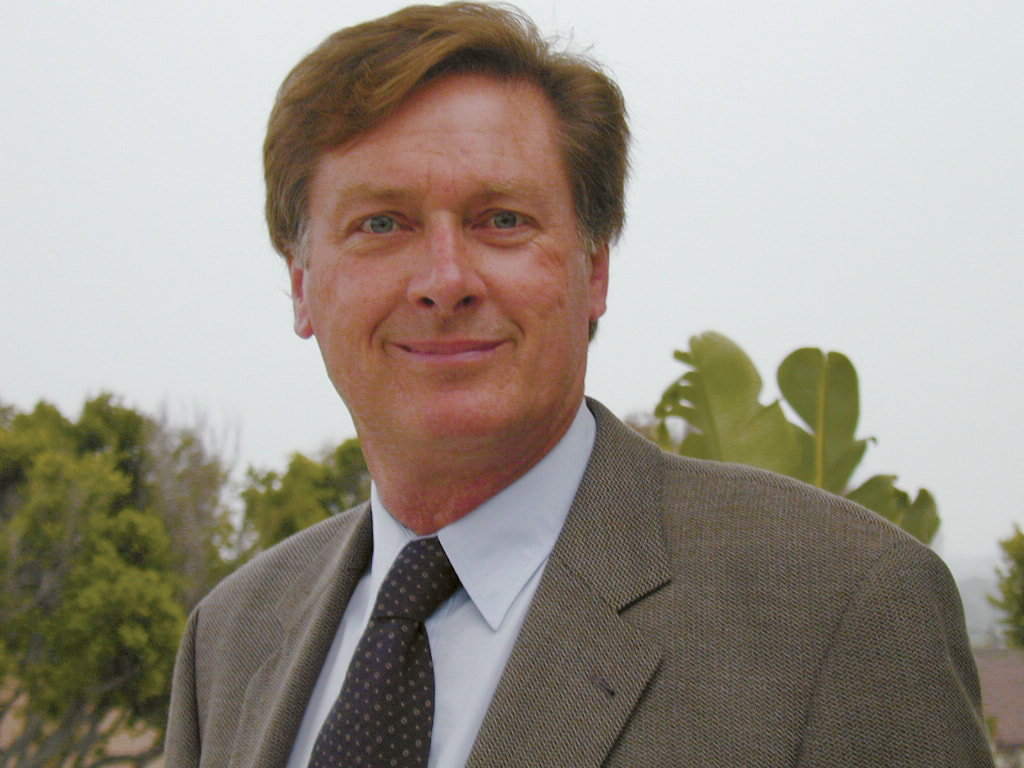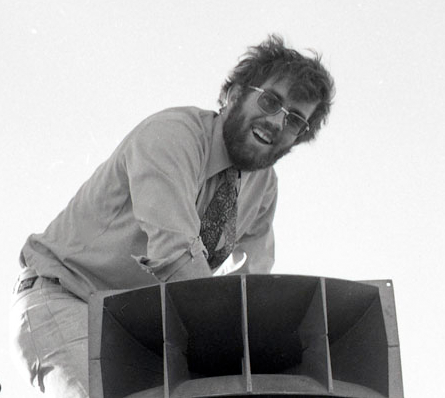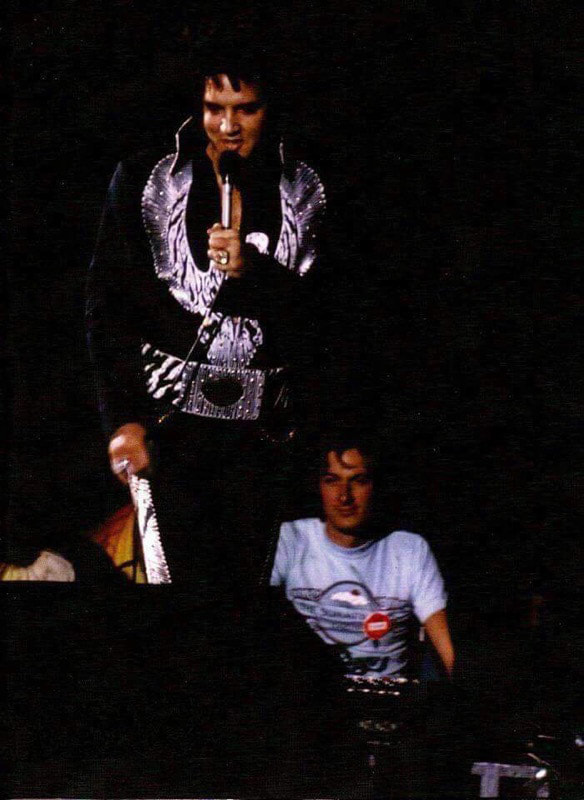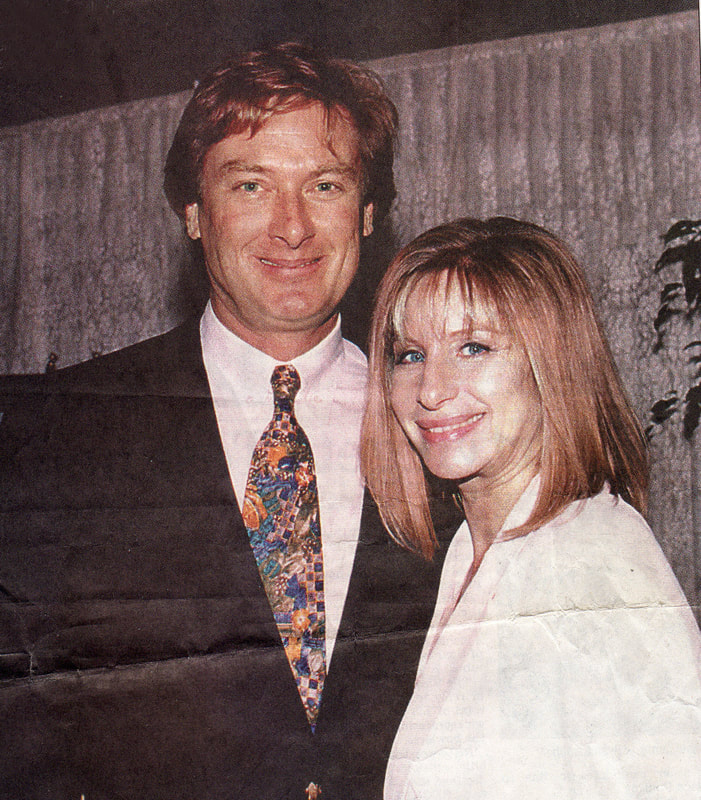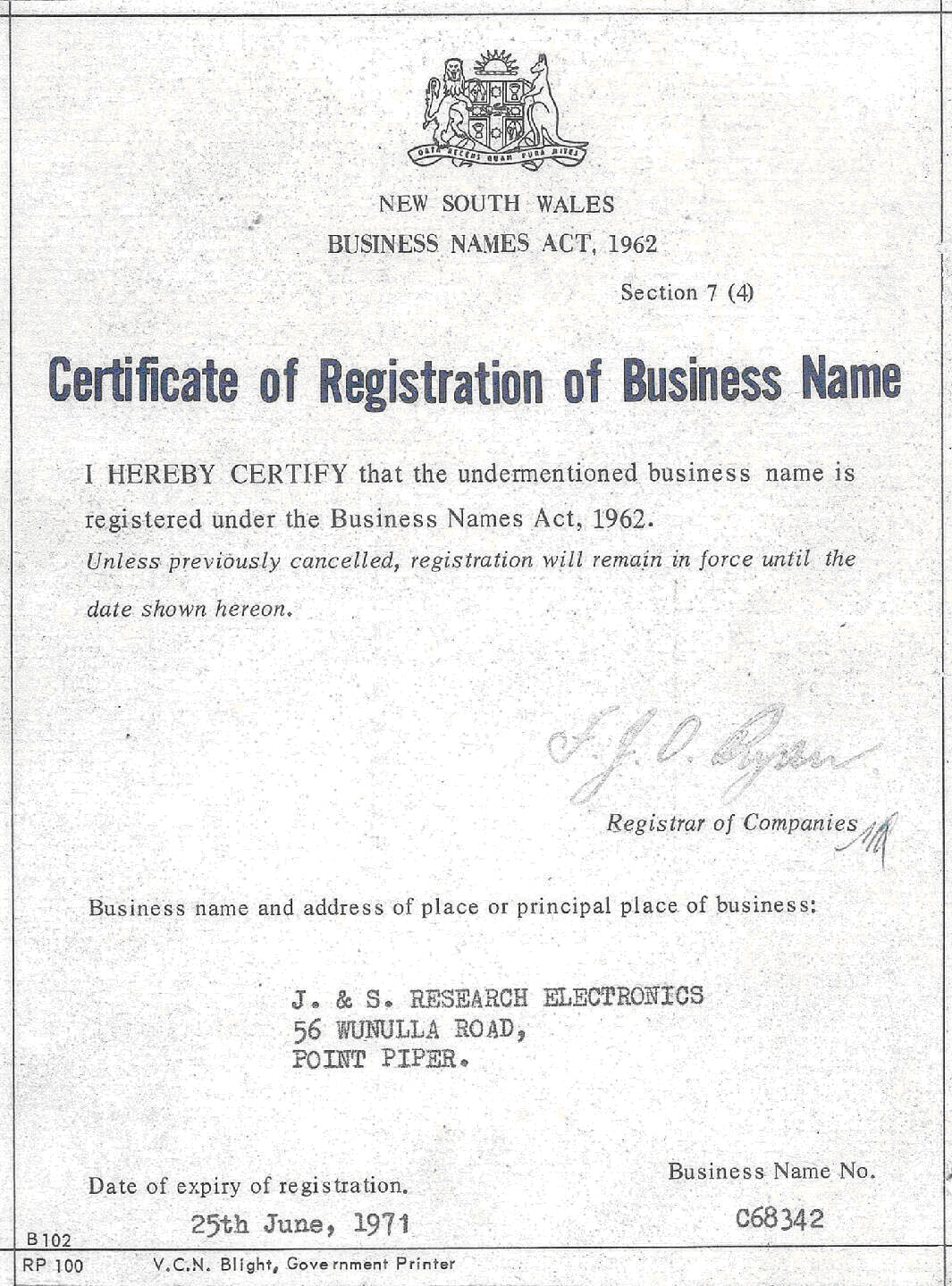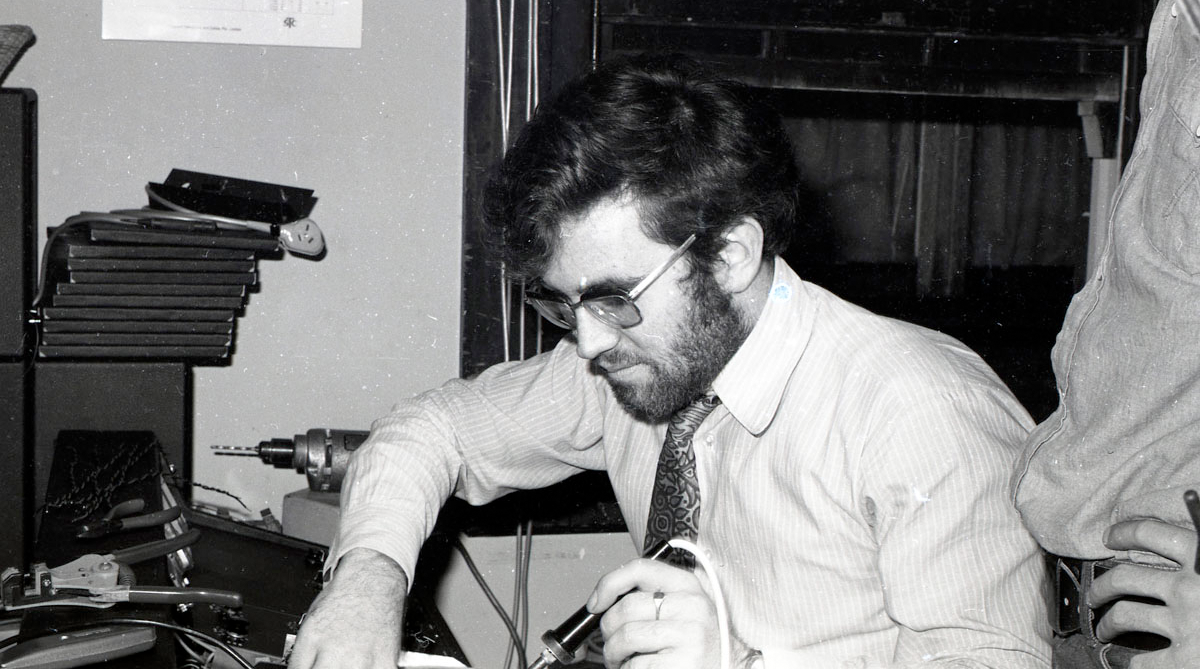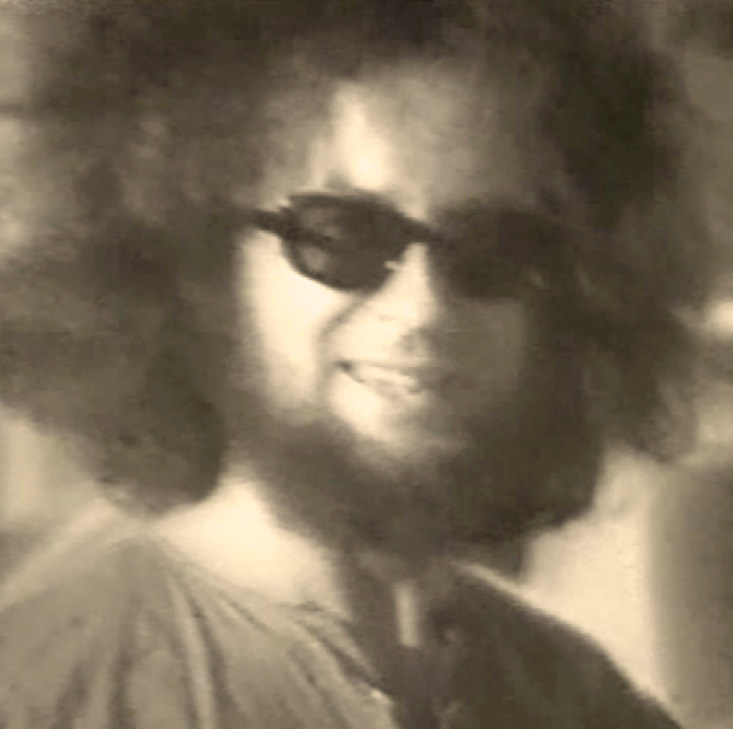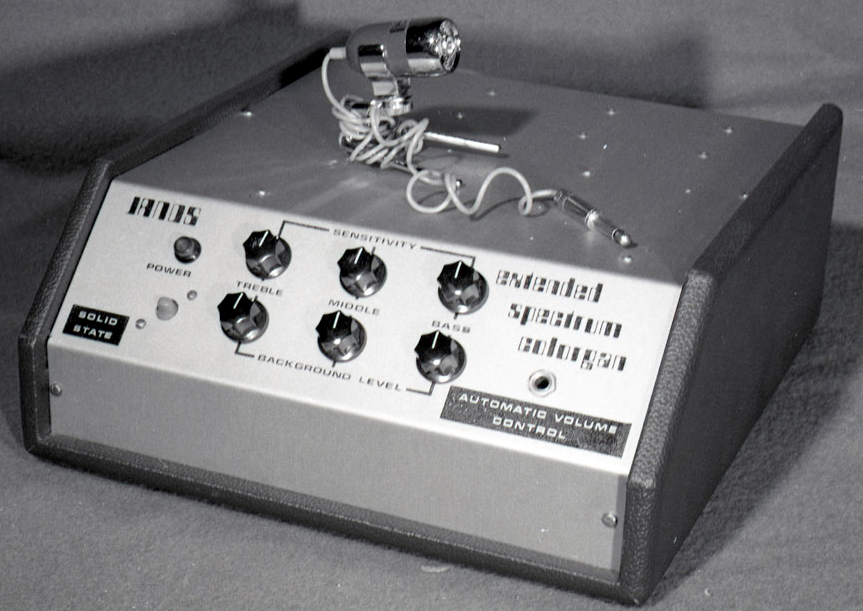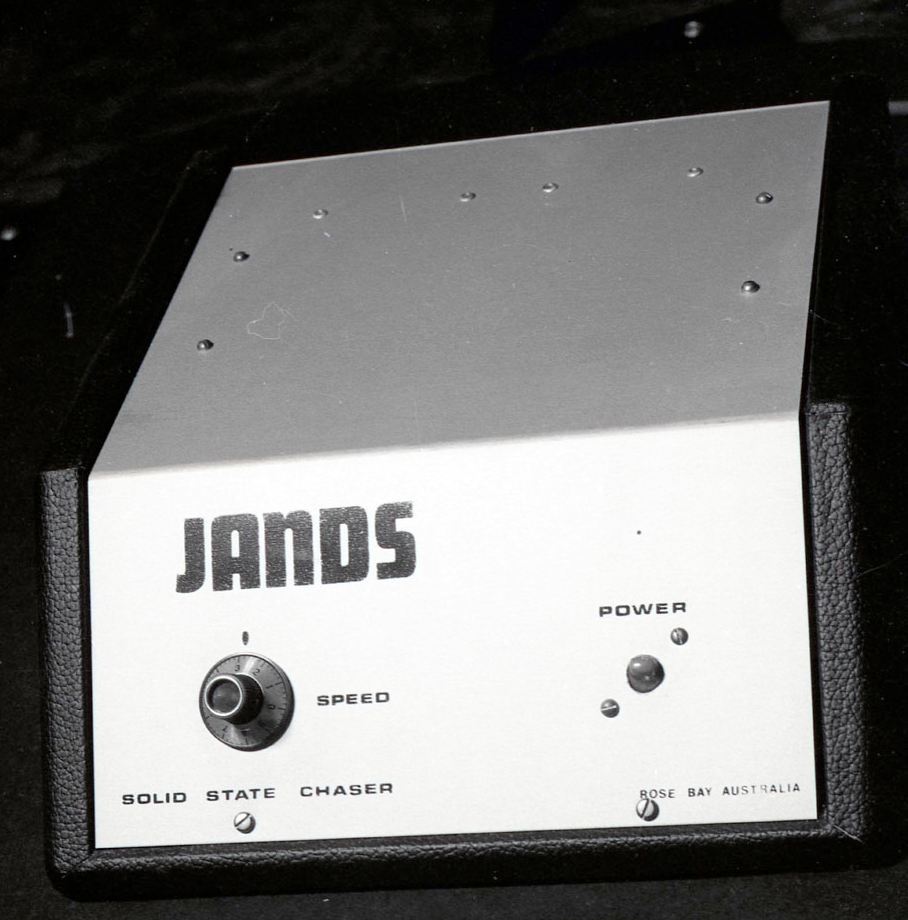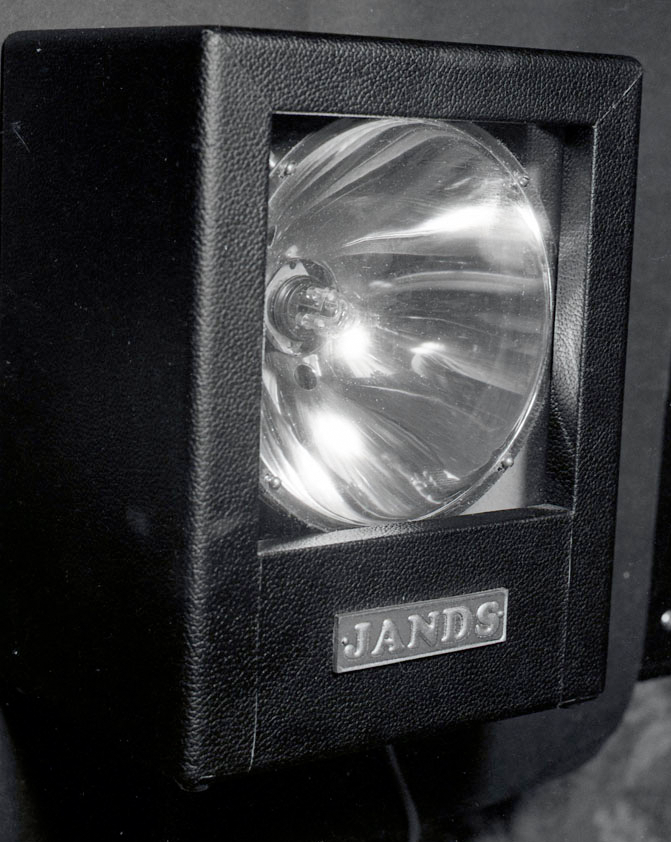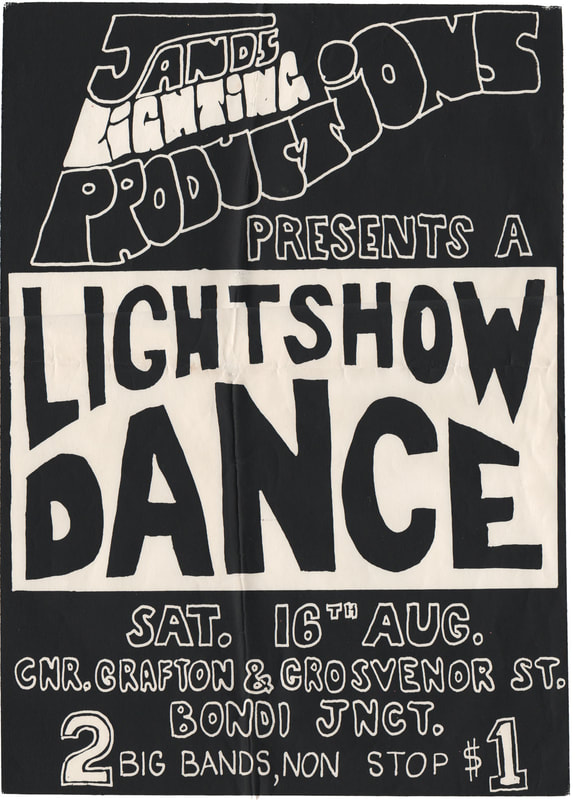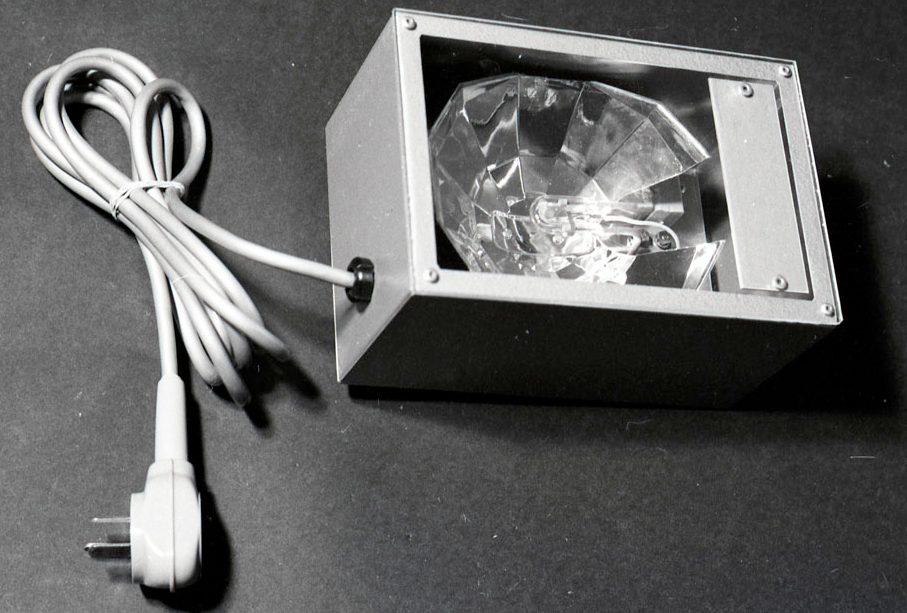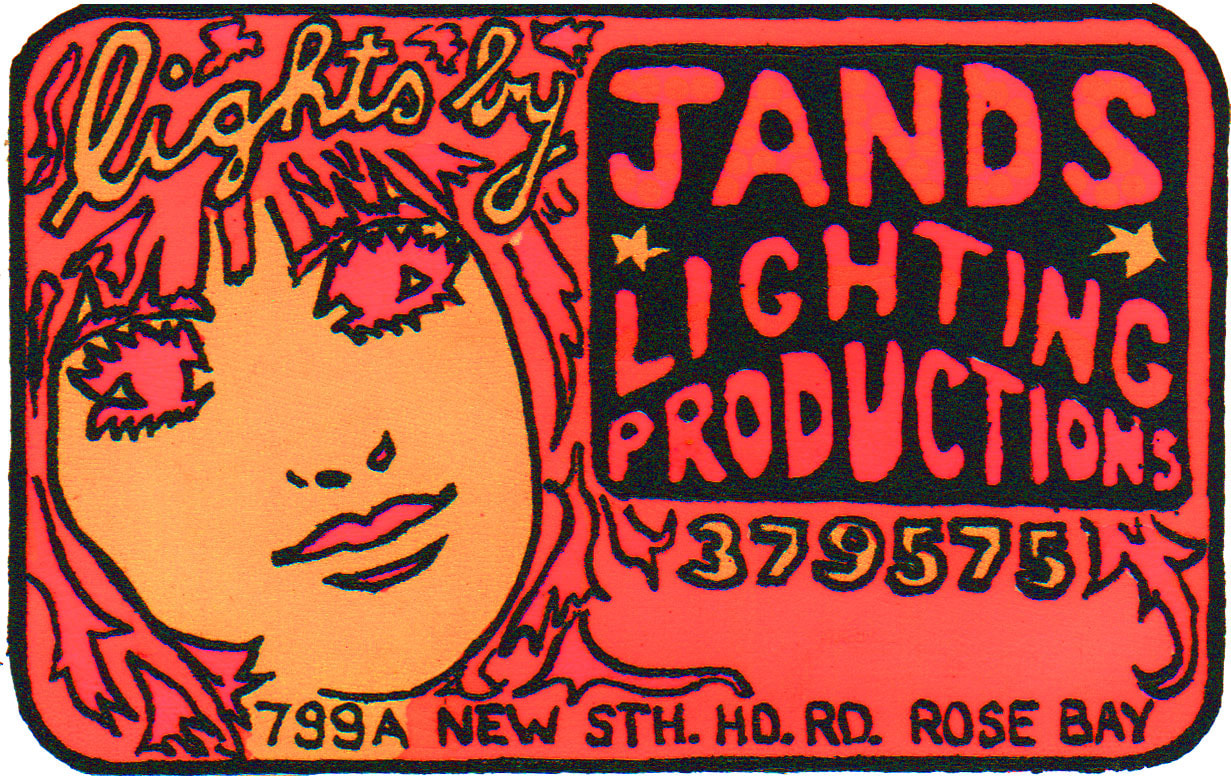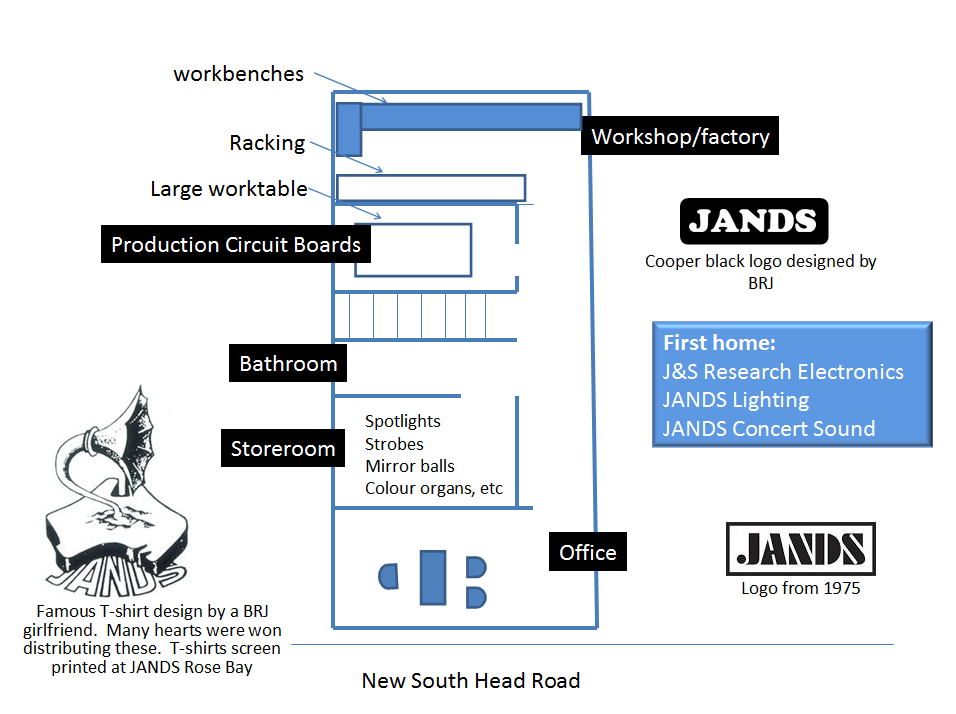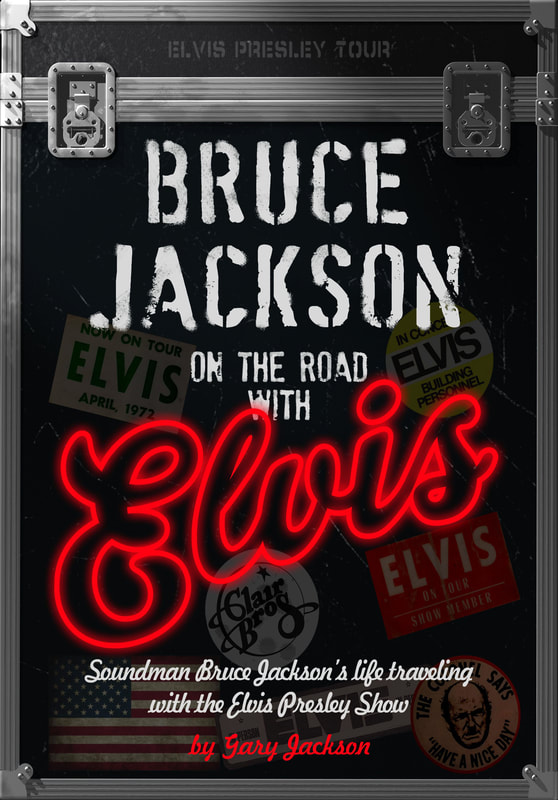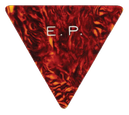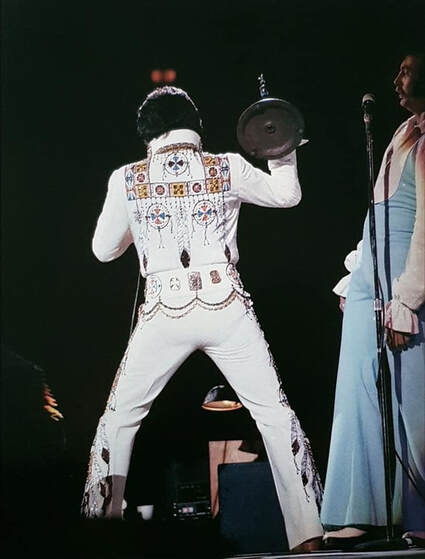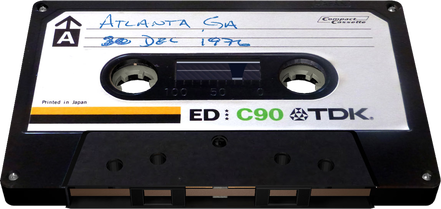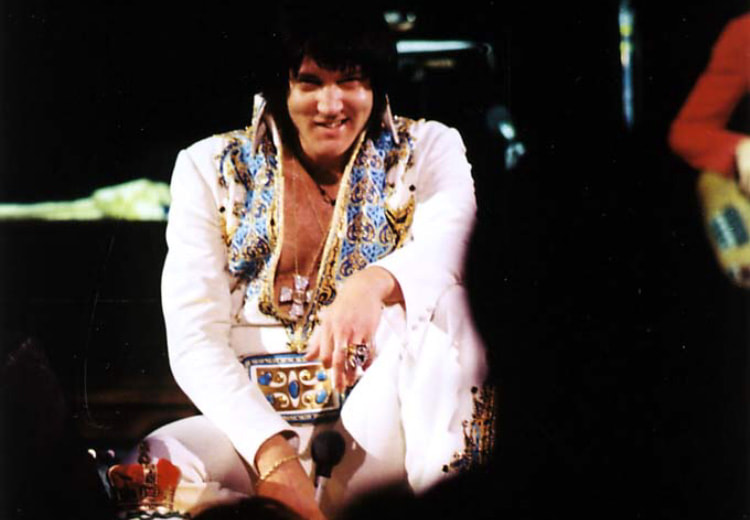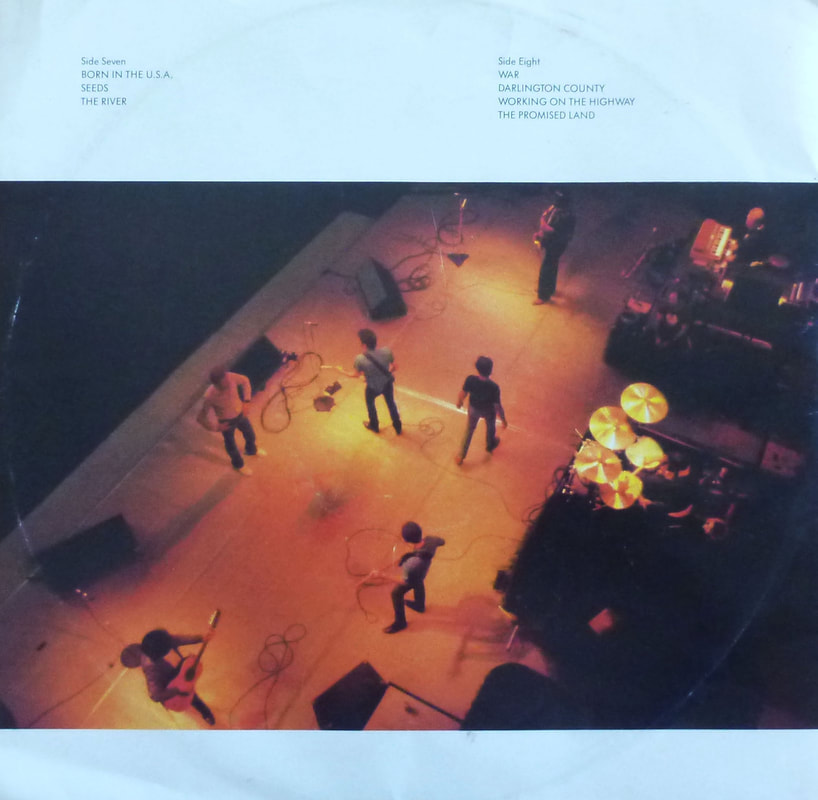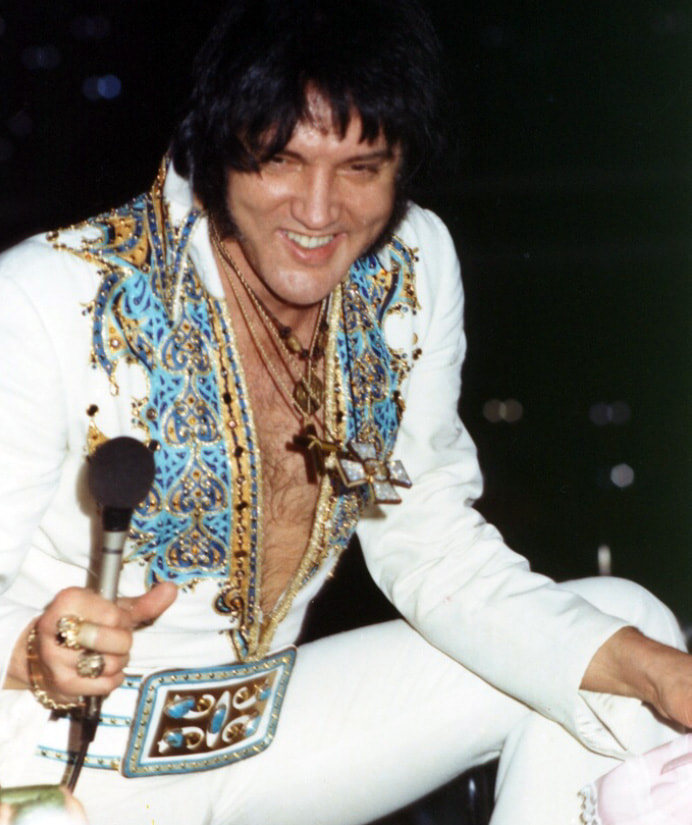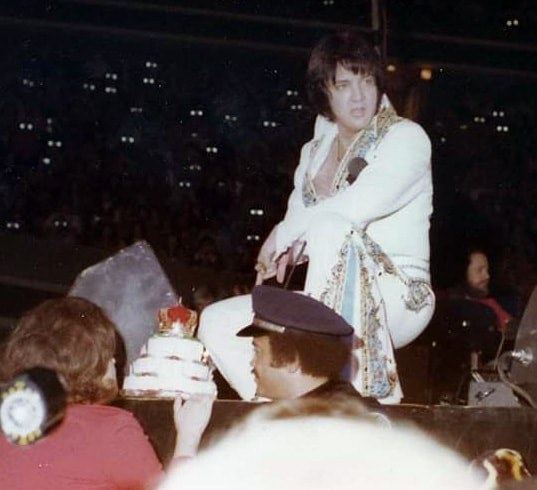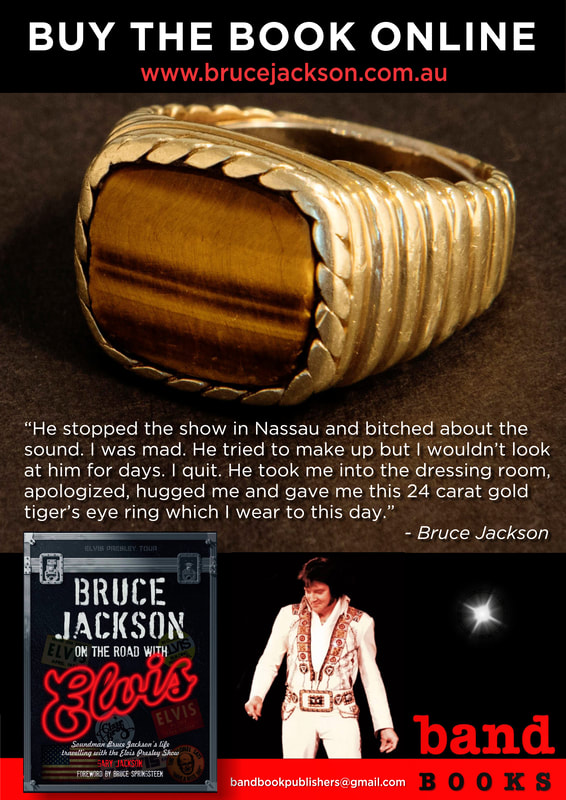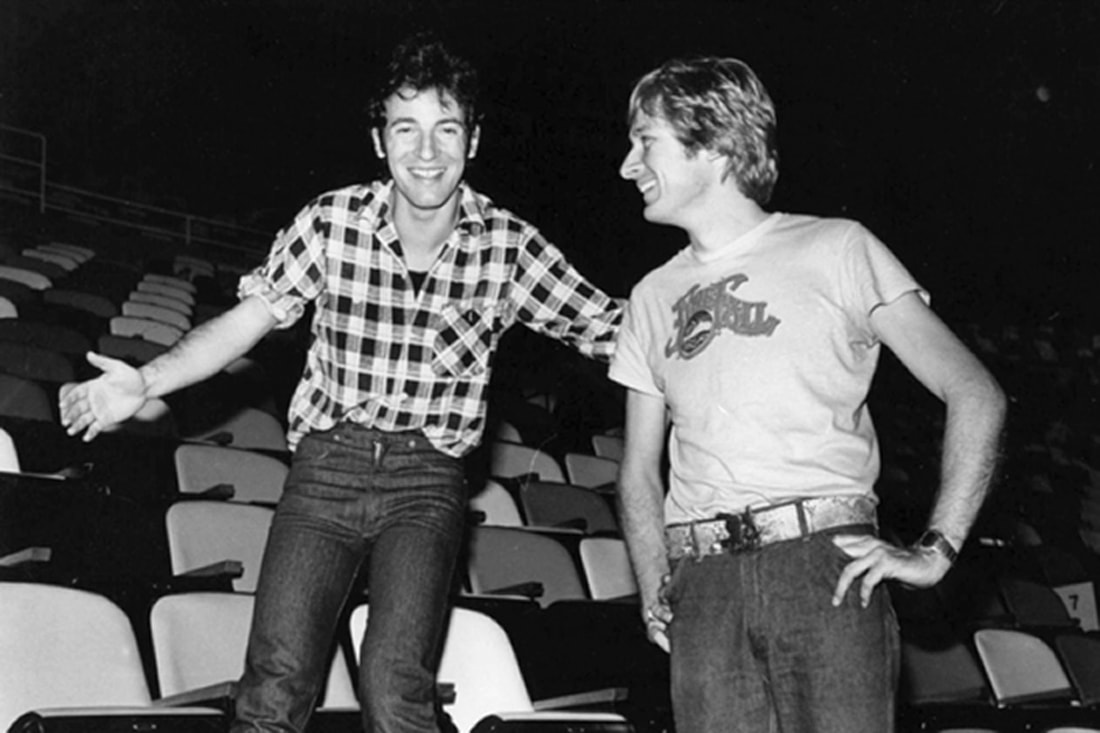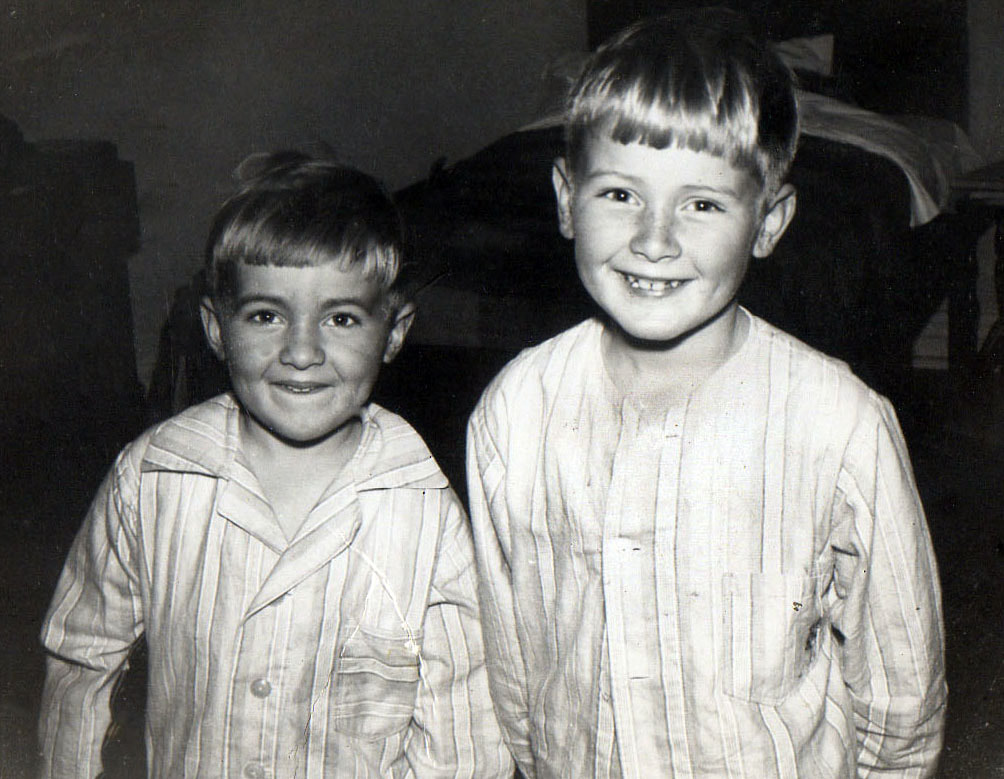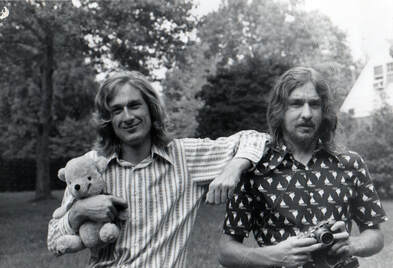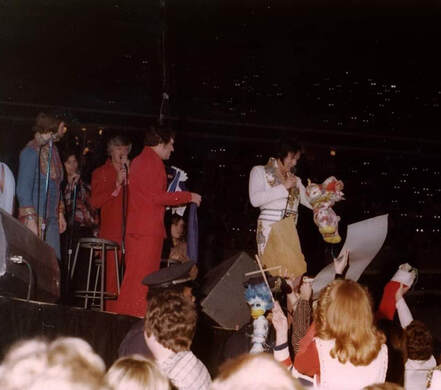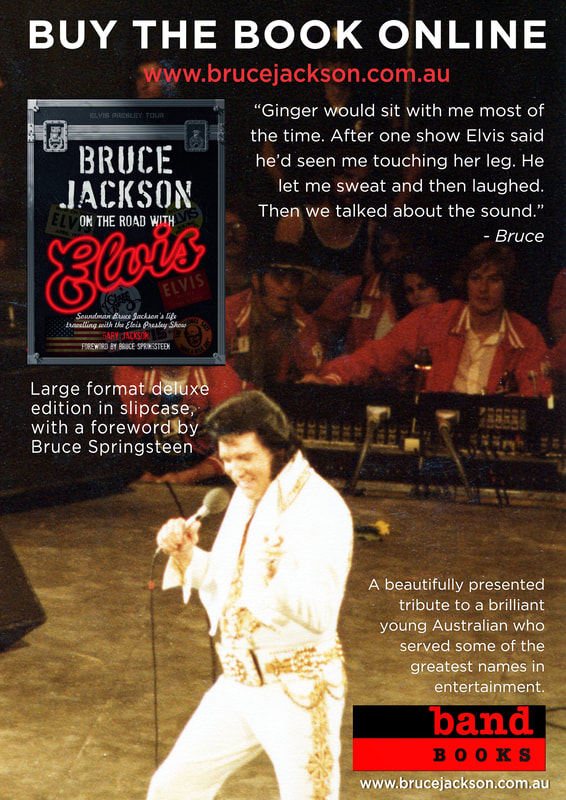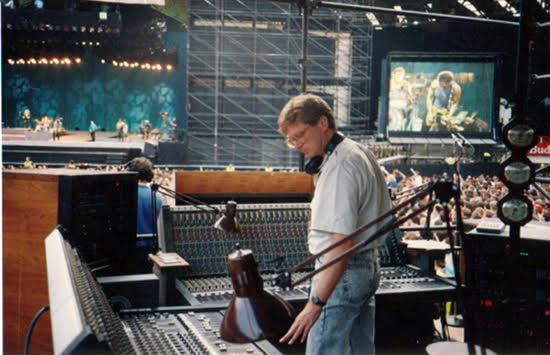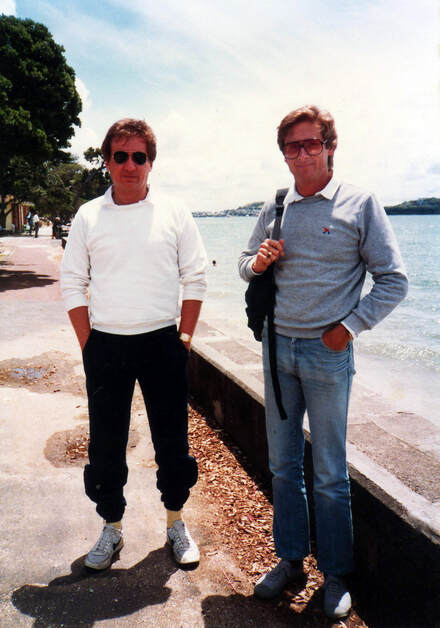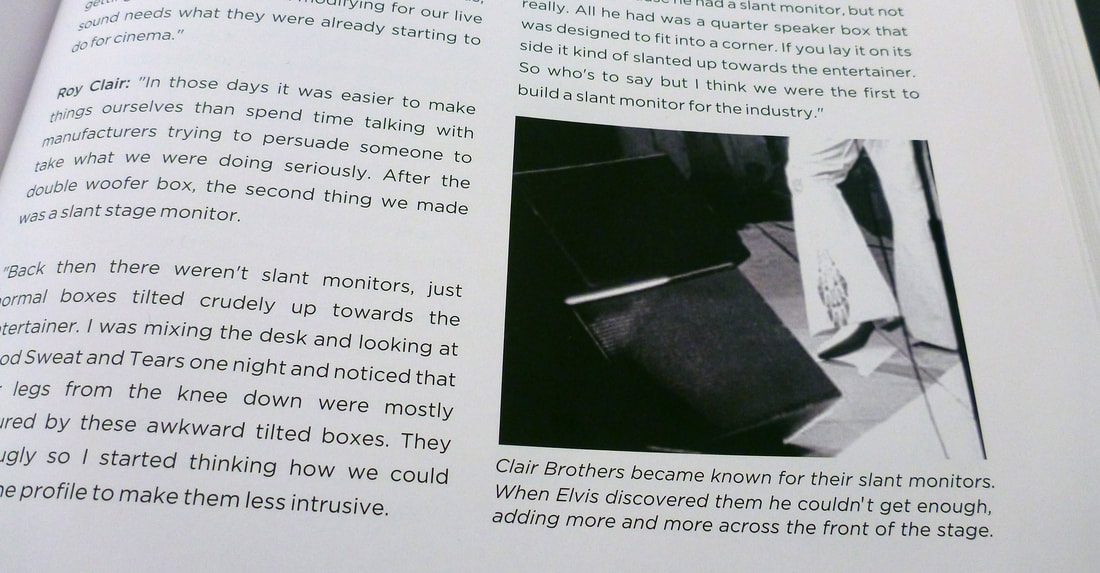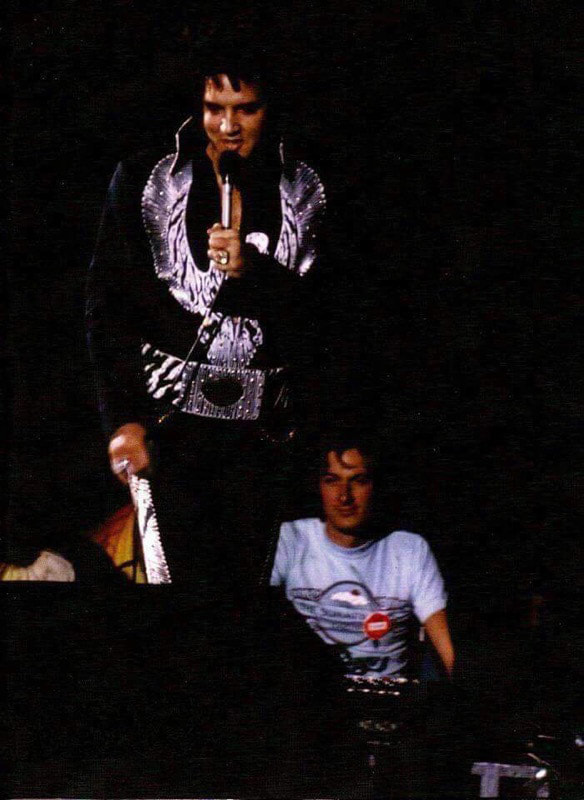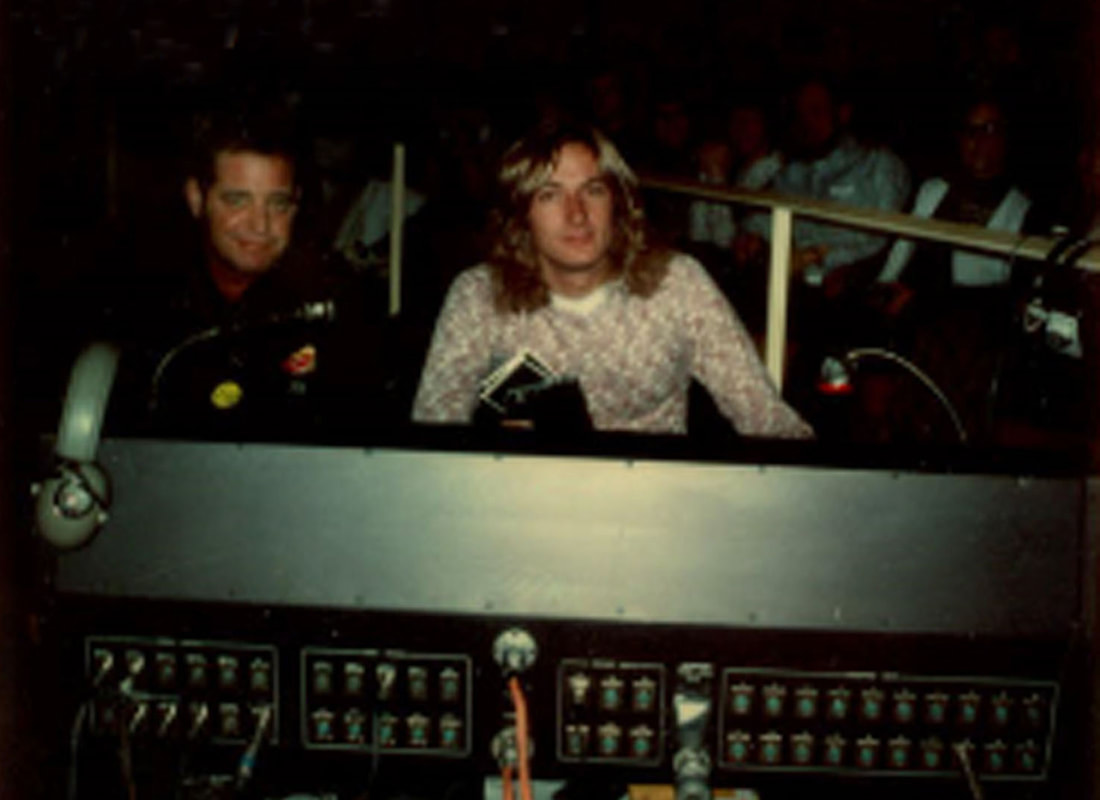|
Bruce Jackson
Phil Storey
Bruce's first tour with Elvis was in November 1971. They used the 'Jackson Board' that Bruce had designed and built with Ron Borthwick at Clair Brothers in a barn in Lititz, Pennsylvania. The board did everything they wanted and was in use for many years, always evolving but the basic design got it right from Day 1. Bruce mixed stage monitors on tour from another desk he built. He sat stage-side and became Elvis's go-to man for any sound question or complaint from feedback to trying new microphones and bigger and better speakers. Bruce was trusted with every aspect of Elvis' touring sound. Such was that trust that Elvis wanted Bruce to be on hand at the Hilton in Las Vegas, which used a house system, just to be there. Bruce said, 'I don't do anything, he just asks me if everything is OK and I say, 'Yes Elvis, everything is fine.'
Bruce had quit touring to concentrate on his new audio research and manufacturing business APOGEE, but was tempted back to live sound by an offer he couldn't refuse for Barbra Streisand's return to the stage after a long hiatus.
J.&S. RESEARCH ELECTRONICS was duly registered in 1968 at our home address. Bruce and Phil worked together in a cramped workshop in the basement with the water-heater before moving to premises in Rose Bay.
Phil working on an idea. Bruce looks on to give advice in the unlikely event that Phil asks for it.
Psychedelic showman, Roger Foley a.k.a. 'Ellis D Fogg,' led the way and brought JANDS their first serious business manufacturing lightshow equipment.
Bruce: "Phil and I each made a $50 capital injection and we started making guitar amps and strobe lights. We made the printed circuit boards ourselves from scratch. We crammed them with more components than strictly necessary to do an adequate job, and we screen printed the front panels. This was something that Roger wasn't doing; at the time there was no one else doing it but us. At first we called our company J & S Research Electronics, for Jackson and Story. Roger would hire gear from us and pay us by cheque when he returned it or we collected it the morning after. He often complained that J & S Research Electronics was too many words to write on the cheque on a Sunday morning so he started abbreviating it to J and S, and our bank was happy enough to accept that. He remarked to Phil, 'You know, you guys should simplify things and call yourselves JandS … make it a word, and you can own it. You could then add the word Amps … JandS Amps. Sounds good". Roger Foley: "Phil liked my idea. He drove straight into the city and registered JANDS. JANDS was Australia’s first lighting, sound and entertainment electronics manufacturing and hiring company. JANDS is still in business and the biggest such company in Australia." Robust and modern. An original JANDS Extended Spectrum Colour-organ with automatic volume control. A black textured vinyl veneer was glued to the outside. .Bruce also experimented with silk screened control panels on brushed aluminium, the first of a long line of rapid developments.
The valve age had ended, luckily for live music concert tours. Gone were the fragile glass tubes unsuited for the harsh treatment that their on-the-road rock & roll application implied. Solid state was durable and compact and had a clean new bullet-proof look and feel.
An early Jands top-of-the-range strobe. It was smart on the inside and robust on the outside. It was said to trigger alpha-wave seizures in the susceptible but we never experienced that ourselves nor witnessed it in others.
Non-stop fun on August 16, 1970. An ominous date being the sad day Elvis died seven years later.
The metal-cased standard-sized strobe light was reasonably priced and popular. They were durable except for the halogen bulb, but we supplied a spare and charged for breakages.
A fluorescent sticker Bruce made in the image of his girlfriend Margaret Dickinson. Most things were done in-house. Posters, T-shirts, flyers and product branding were silk screened. Bruce did the artwork and printing.
Margaret provided huge support, going along to concerts, getting her hands dirty coiling cables and keeping spirits up when tiredness threatened to overwhelm. Adrian Wood drew up this diagram to show how things were organized in the JANDS birthplace, an old residential flat used as an office and factory. Adrian Wood: "The backroom was the workshop and electronics assembly line. In the next room we made circuit boards via screen printing and acid etching using copper-sulphate photo-resist. We also screen printed posters, handbills and T-shirts on a big work table, which Bruce and Phillip hand-made". We made our own mirror balls in three sizes. Bruce included family in production activities wherever possible, such as paying our mother to glue hundreds of little two centimetre square mirrors with Araldite onto forty centimetre diameter fibreglass balls to make those mirror balls. Yes it was getting close to mindless slave labour but our mother was more than willing to help and insisted that she not be paid. JANDS also made crystal colour balls; strobe units; colour organs; chasers; amplifiers; speaker crossovers; and eventually some rather crude lightshow controllers. We bought in spot lights and flood lights, and fog machines which Phillip modified for longer, better, bigger effects. We used the bathroom for mixing chemicals, permanently staining the old sink, bath and toilet. Past the stairs was a small room where most of the hire equipment was stored. JANDS had a very good relationship with Strand Electric, the UK-based company that manufactured the world’s best theatre lamps, so we had a lot their spot lights and flood lights. We also stocked, for sale and hire, strobe lights; colour organs; chaser lights; fog machines; a few guitar amps; maybe 8 or 10 PAs; microphones (AKG mainly), with some Sennheiser as they were good for drum re-enforcement".
"We kept the speaker cabinets stacked in the hallway, but rarely all of them because there wasn't room. Rather than carry them up the narrow stairs only to carry them down again, often they were just left in the back of the blue Ford Transit van that served as delivery truck, mobile bar, party machine and emergency overnight accommodation". Read the full JANDS story and what happened next, in my book (www.brucejackson.com.au)
|
JANDS STANDS
|
Click on the plectrum to buy the book.
|
Huntsville, Alabama June 1 1975
|
"Watch that feedback, Jackson!"
Bruce brought an air of professionalism to Elvis' live sound that it did not have pre-Nov 1971. Only Bruce had the foresight to record Elvis live, without which a great historical and musical legacy would have been lost forever. Aficionados of Elvis' music owe him a great debt of gratitude.
Like many admirers of Elvis' music, I have all the FTD concerts and have heard all the quips - "Watch that feedback!" and the famous "Happy birthday Bruce, goose!" They had a great workaday relationship that has only grown in significance with the passing of time. I'm pretty sure someone somewhere will be listening to Bruce's soundboard material in a hundred years from now. Notwithstanding the limitations of soundboard recordings, they sound like they were recorded yesterday. The book is a wonderful gesture by you, and an essential record of an amazing life. - Noel Shine |
|
JANUARY 30, 2020
"It is amazing that he could take any song from the air and sing it without fail" - Gary Jackson recalls Elvis Presley Gary Jackson, younger brother of the legendary sound engineer, Bruce Jackson, specifically for ELVIS: Promised Land
Contemporary big concerts, events or music events are hard to imagine without the achievements of one man, the sound engineer Bruce Jackson. Many of his ideas and technical solutions, such as lifting speakers from the floor to the ceiling, have been used to this day. "Bruce should have his street in Sydney. I think it is an absolute legend, "one Australian ABC Radio journalist said. In turn, Julius Grafton from CX Magazine added: "He knew more about electronics than anyone else I met." Beginning in 1971, Bruce began working for Elvis Presley (both in the photo on the left). He played hundreds of concerts with the legendary king of rock'n'roll.
A few weeks ago, an excellent book, Bruce Jackson, went on sale. On The Road With Elvis' by his younger brother, Gary, who was largely based on Bruce's memories (letters, postcards, audio cassettes) sent home directly from concert tours. A few hours ago, however, Gary Jackson gave me a very extensive and extremely interesting interview, which allows us to get to know the famous concerts of Elvis from the so-called "Kitchen". Due to the very large amount of material, today I present only the first part. Another tomorrow and Saturday. Mariusz Ogiegło: Gary, let's start this interview with a topic that has been igniting the imagination of many Elvis fans around the world for several days. Also here in Poland. This is the fragment of Elvis's concert from December 30, 1976 available on your website. Until now, this material was known only from amateur recordings. Now we receive a recording with professional sound quality directly from the mixing table, the so-called soundboard.
Please tell me more about this recording (recorded by your brother, Bruce Jackson). Is that the only part? Or did your brother record the whole performance? Gary Jackson: Yes, Bruce recorded the entire show, all the way past 'Elvis has left the building.' The recording comes from his soundboard feed as it did for every show. At that stage the soundboards were made on TDK C90 Compact Audio Cassettes. The little cassettes had a tape width of just over an eighth of an inch, or 3.81mm. He'd give one copy to tour manager Tom Diskin at the end of the show, and keep a copy for himself.
He often sent extra copies home to me in Australia, by airmail, as he did with this one. When it arrived in January 1977, just a few days after the show, I was excited as you can imagine. I played it to some friends. Interestingly, it seemed that no one in Australia but me was interested in Elvis … he wasn't seen as cool. The Atlanta show was a happy event. Such a night! Elvis was in fine form and in love with Ginger. His health had improved, he was in a good mood and was singing songs he had rarely or had never performed before, like 'Such A Night', just the third time he had attempted it in the last six years and by far the best version. Who else but Elvis could sing, perfectly, anything he wanted, anytime he wanted? 'Reconsider Baby' was back in the setlist, the first time since 1972 and 'Unchained Melody' had been performed just four times since the tour began on December 26. Elvis was really upbeat which made the concert-following fans think 'he’s back!' He seemed genuinely touched that fans made him a cake and sang happy birthday to him. Everything just came together to make it a special show. All this made this show unique. LISTEN! ELVIS PRESLEY - CONCERT OF THE CONCERT AT ATLANTA, 30 DECEMBER 1976 (SOUNDBOARD, Rec. Bruce Jackson)
Is the show from Atlanta the only concert recorded by your brother? I'm asking this because I've been informed once that some artists have asked their Technicians/Sound Engineers or trusted people to record every show in order to be able to analyze it with their band members. This method was used, amongst others, by the legendary Polish singer Czesław Nieman.
Yes, Bruce recorded almost every show he did, and not just with Elvis. Bruce did every Springsteen show for ten years from 1978.
In about 1985 Bruce Springsteen said to Bruce Jackson, 'I wish we had recorded all my shows.' Bruce Jackson said, 'I did! The tapes are in a box under my bed.' Those tapes were used to make a five album set that became the biggest-selling live box set ever. This is a picture of one of the covers. That's Bruce Jackson in the white shirt with his hands on his hips.
Recording every show was done for a few reasons. One was to allow review of each show by the artist and/or band to see what could be improved. Another reason was in case there was a dispute, such as with the venue over any performance or technical issue. Another reason of course was that each live performance was valuable and would otherwise endure only in the memory of the audience who happened to be there on the night. Bruce realised that and made many recordings on his own initiative for that reason. We have tapes Bruce made that we haven't listened to. One, a quarter-inch reel-to-reel we did listen to at random is a unique recording of a Carly Simon and James Taylor show at the Bottom Line Club in New York. Carly was making a comeback to live performances and was extremely nervous. James went on and did part of the show. We're glad that Bruce made the effort at the time to record it. We have much more to discover. Elvis was a perfectionist and this way of working suited him very well. Do You think it was possible? Did Your brother ever mention anything to You or talk to Elvis about it?
Yes, we as his family knew that Bruce was a perfectionist, not that he every said, 'I am a perfectionist'. It was evident from the way he operated. It seemed that nothing was good enough, that everything just needed a little more work before he was happy with it. Bruce's reputation as a perfectionist was widespread even before he left Australia to work for Elvis. His attitude annoyed some of the people he worked with, people who were happy to go with, 'It's good enough, let's go'. On the road, if something wasn't quite right during the show set-up, Roadies would re-do it because they knew Bruce would notice and would ask them to fix it. They preferred to do it again get it right without being asked, than have Bruce tell them to do it again. He was hard to work with but his pursuit of perfection made for a better show. He was always looking for a better way to do something.
Of course, as Salvador Dali noted, 'Do not concern yourself with perfection, you will never achieve it', but in Elvis' case it seemed that he came very close to it. The quest for perfection is, however, a productive driving force. Bruce and Elvis both had it. For that reason alone they worked well together although when you have two people working so closely together for the same goal like that there are bound to be some conflicts, and there were between Bruce and Elvis until they got to know each other and realise that were both perfectionists. In both cases it seemed to be a natural part of their particular genius. I wonder did Elvis have to work at being so good or did it just come naturally? Was publicizing large concerts Bruce's main occupation? Bruce worked for Clair Brothers Audio in Lititz, then a small sound company in a small country town in Pennsylvania. When Bruce wasn't out on the road with Elvis or someone else (like Glen Campbell, Blood Sweat and Tears, Johnny Cash, The Jackson Five and more) he was in the workshop designing new equipment. In particular there was one big project that Bruce conceived for Elvis and perfected after much hard work. That was the famous multi-channel mixing console that Bruce first used on the road with Elvis and was so good it was used for the next twenty years by Clair Brothers. Bruce had gone across to the US to work for Clair Brothers in the middle of 1970, when he was just twenty one. It was over a year before he did the first tour with Elvis in November 1971. The 'Jackson Board' took many hundreds of hours designing and redesigning with another genius, Clair Brothers employee Ron Borthwick. It must have been hard at times for Ron as Bruce was never satisfied, always wanting more work on a detail or new specification. Ron knew how to make anything work and work reliably but it was never good enough for Bruce. It would have gone on uncompleted for much longer if in September 1971 Clair Brothers hadn't been asked to do Elvis' touring sound, starting in two months. That was the motivation to get the board finished and ready to go on the road. Of course, Bruce and Ron kept on making improvement after improvement along the way. Clair Brothers still have it, but now they are known as Clair Global. Elvis was open to such experiments during his performances? Elvis started working with Bruce on technical improvements once he realised that he was sounding so good on stage, better than he was sounding at the Las Vegas Hilton and the other Casino towns. Elvis complained that he couldn't hear himself on stage, so Bruce introduced custom stage monitors that Roy Clair designed. These were the first prototype wedge-shaped, low-profile fold back speakers in the concert sound industry. It made Elvis so happy, he wanted more of them. As the importance of stage monitors grew, Bruce moved from the main desk down to a mixing position right at the edge of the stage, where he could communicate directly with Elvis during the show. Elvis would just have to look at Bruce and make a gesture with his hand or eye for Bruce to know what he wanted. Elvis liked the benefit of the monitors so much that he had Bruce add more and more across the front of the stage, you can see in later shows how many there were. Of course, having so many monitors so close to Elvis's microphone meant that feedback was a constant problem and you can hear in soundboard recordings Elvis warning Bruce to, 'Watch that feedback!' Sometimes Elvis would put his microphone close to a monitor to intentionally cause feedback, just to mess with Bruce and keep him on his toes. Elvis would do it, then look at Bruce and laugh. w.brucejackson.com.au When picking up the album of our favorite artist or going to his performance to the great concert hall, we often forget about people who, although perhaps invisible, co-create the spectacle with him and make us leave it full of unforgettable impressions. Bruce Jackson, a brilliant Australian sound engineer, worked for Elvis Presley for six years. At that time, he revolutionized not only the sound of his live performances but also the entire contemporary public address industry. Yesterday, Bruce's younger brother Gary (both in the picture on the left), who is also the author of the excellent book "Bruce Jackson, told me about the backstage of his collaboration with Elvis as well as the beginnings in the industry. On The Road With Elvis. " Below I present to you the second part of our conversation, which I hope, like the first, will meet with your warm welcome.
Mariusz Ogiegło: One would like to say the whole of Elvis. But just in addition to a great sense of humor, Elvis was also famous for his attention to the right sound, attention to almost every detail. In the recording studio he could repeat the song twenty or thirty times. As long as he didn't think it sounded satisfactory. And what did preparations for the concerts look like? Was Elvis interested in how the facility will be publicized, what solutions will be used in it? Discussed / advised this type of thing with your brother?
Your brother, Bruce, worked with Elvis for six years. But before I'll ask you about it, please tell me, what did he do before?
Bruce dropped out of an Electrical Engineering Degree course at a university in Sydney in 1968 to start a sound and lightshow company called JANDS, with a school friend Phil Story. The name was derived from 'Jackson AND Story.' It was the psychedelic sixties and their company was an innovator and leader. They designed and made lighting-effect equipment like stroboscopes, colour organs and fog machines and designed and made very powerful solid-state amplifiers, which they hired out to university balls and dances and music events.
They were among the first to develop this industry and were soon famous for it. They sold the company in 1970 when Bruce's interest in sound reinforcement grew and he designed and made in his Workshop the most powerful amplified that existed at the time anywhere in the world. He was looking for something bigger than JANDS and had his eyes set on America. Fifty years later, Jands is still by far the biggest concert sound company in Australia. When and in what circumstances Bruce get to Elvis' group? How did he mention his first meeting with Elvis? The first concert he played together (did You remember when and where it was)?
|
STYCZEŃ 30, 2020
„To jest niesamowite, że potrafił wziąć dowolną piosenkę z powietrza i zaśpiewać ją bezbłędnie” – Gary Jackson wspomina Elvisa Presleya Gary Jackson, młodszy brat legendarnego dźwiękowca, Bruce’a Jacksona specjalnie dla ELVIS: Promised
Współczesne wielkie koncerty, eventy czy wydarzenia muzyczne ciężko sobie wyobrazić bez dokonań jednego człowieka, inżyniera dźwięku Bruce’a Jacksona. Wiele jego pomysłów i rozwiązań technicznych, takich jak chociażby uniesienie kolumn głośnikowych z podłogi pod sufit, stosowanych jest po dzień dzisiejszy. „Bruce powinien mieć swoją ulicę w Sydney. Myślę, że jest absolutną legendą„, uważał jeden z dziennikarzy australijskiego ABC Radio. Z kolei Julius Grafton z Magazynu CX dodał: „Wiedział o elektronice więcej niż ktokolwiek inny kogo spotkałem„.
Począwszy od 1971 roku Bruce zaczął pracować dla Elvisa Presleya (obaj na zdjęciu po lewej). Z legendarnym królem rock’n’rolla zagrał setki koncertów. Przed kilkoma tygodniami do sprzedaży trafiła doskonała książka, „Bruce Jackson. On The Road With Elvis” autorstwa jego młodszego brata, Gary’ego, która w znacznej części oparta została na wspomnieniach Bruce’a (listach, pocztówkach, kasetach audio) przesyłanych do domu bezpośrednio z tras koncertowych. Kilka godzin temu natomiast, Gary Jackson, udzielił mi bardzo obszernego i szalenie interesującego wywiadu, który pozwala poznać nam słynne koncerty Elvisa od tzw. „kuchni”. Z racji bardzo dużej ilości materiału, dzisiaj prezentuję tylko część pierwszą. Kolejne jutro i w sobotę. Mariusz Ogiegło: Gary, zacznijmy ten wywiad od tematu, który od kilku dni rozpala wyobraźnię wielu fanów Elvisa na całym świecie. Także tutaj, w Polsce. A mianowicie od udostępnionego na Twojej stronie internetowej fragmentu koncertu Elvisa z 30 grudnia 1976. Dotychczas materiał ten znany był jedynie z amatorskich nagrań. Teraz otrzymaliśmy nagranie z profesjonalną jakością dźwięku wprost ze stołu mikserskiego, tzw. soundboard. Proszę powiedz kilka słów na temat historii tego nagrania (za którym stoi Twój brat, Bruce Jackson). Czy to jedyny zachowany fragment czy może Twój brat rejestrował ten występ w całości? Gary Jackson: Tak, Bruce nagrał ten występ w całości. Aż do momentu gdy rozległo się słynne ‚Elvis opuścił budynek’ (‚Elvis has left the building’). Nagranie zostało wykonane w jakości soundboard, podobnie jak Bruce robił to przy każdym występie. Na tym etapie soundboardy były rejestrowane na kasety Compact Audio TDK C90. Te małe kasety miały taśmę szerokości jednej ósmej cala, tj. 3,81 mm. Po występie Bruce oddawał jedną kopię kierownikowi trasy, Tomowi Diskinowi a drugą zatrzymywał dla siebie. Często wysyłał też dodatkowe kopie do mnie, do domu w Australii pocztą lotniczą. Tak jak zrobił to w tym konkretnym przypadku.
Kiedy przesyłka przyleciała w styczniu 1977 roku, zaledwie kilka dni po koncercie, byłem podekscytowany. Co możesz sobie wyobrazić. Zagrałem to niektórym swoim przyjaciołom. Co ciekawe, wydawało się, że wówczas nikt w Australii poza mną nie był zainteresowany Elvisem. Nikt nie postrzegał, że jest cool. Koncert w Atlancie był udany. Co za noc! Elvis był w dobrej formie i zakochany w Ginger. Jego zdrowie się poprawiło, był w dobrym nastroju i śpiewał piosenki, których rzadko lub w ogóle nie włączał do swoich wcześniejszych występów. Takie jak chociażby „Such A Night”, które spróbował wykonać dopiero po raz trzeci w ciągu ostatnich sześciu lat. I ta wersja była zdecydowanie najlepsza. Ale, któż inny jak nie Elvis mógł zaśpiewać idealnie wszystko co chciał i wtedy kiedy chciał? „Reconsider Baby” wróciło do setlisty po raz pierwszy od 1972 roku, a „Unchained Melody” wykonywana była zaledwie cztery razy od chwili kiedy 26 grudnia wystartowało tournee. Elvis był naprawdę przebojowy co sprawiło, że fani obecni na koncercie przez chwilę pomyśleli „on wrócił!”. Ponadto wydawał się być prawdziwie wzruszony gdy upiekli mu ciasto urodzinowe i zaśpiewali dla niego „Happy Birthday”. To wszystko razem czyniło ten show wyjątkowym. POSŁUCHAJ! ELVIS PRESLEY – FRAGMENT KONCERTU W ATLANCIE, 30 GRUDNIA 1976 (SOUNDBOARD, Nagr. Bruce Jackson) Wspomniałeś, że ten show w Atlancie nie był jedynym nagranym przez Twojego brata. Było ich więcej? Pytam o to ponieważ spotkałem się kiedyś z informacją, że niektórzy artyści prosili swoich techników/dźwiękowców lub zaufane osoby o nagrywanie każdego występu by móc później analizować jego przebieg z członkami swojego zespołu. Taką metodę stosował m.in legendarny polski piosenkarz Czesław Niemen (o czym dowiedziałem się od jego kuzyna, Romualda Wydrzyckiego).
Oczywiście. Bruce nagrywał praktycznie każdy koncert przy którym pracował. I to nie tylko te, które zrobił z Elvisem. Począwszy od 1978 roku przez dziesięć kolejnych lat Bruce pracował przy każdym występie Springsteena. Około 1985 roku Bruce Springsteen powiedział mu: „chciałbym żebyś nagrywał wszystkie moje koncerty„. Na co Bruce odpowiedział: „Już nagrałem. Te kastey są w pudełku pod moim łóżkiem„. Tych taśm użyto do stworzenia zestawu pięciu albumów, które stały się najl epiej sprzedającym się zestawem boxów koncertowych w historii. Nagrywanie każdego występu odbywało się z kilku powodów.
Jednym z nich było umożliwienie artyście/zespołowi wglądu w każdy koncert by zobaczyć co np. można w nim poprawić. Z drugiej strony postępowano tak na wypadek gdyby zaistniał spór np. z miejscem w którym odbywała się impreza, o wszelkie działania lub kwestie techniczne. Jeszcze innym powodem był oczywiście fakt, że każdy występ ‚na żywo’ był cenny i w przeciwnym razie przetrwałby jedynie w pamięci publiczności, która widziała go danej nocy. Bruce zdawał sobie z tego sprawę i z własnej inicjatywy dokonał wielu nagrań. Mamy jego taśmy, których jeszcze nie słuchaliśmy. Raz, przeglądając je na chybił trafił, trafiliśmy na unikalne nagranie występu Carly Simon i Jamesa Taylora w Botton Line Club w Nowym Jorku. Carly wracała wtedy do występów na żywo i była bardzo zdenerwowana. James zrobił większą część koncertu. Cieszymy się, że Bruce podjął wysiłek w tamtym czasie by to nagrać. Mamy jeszcze tyle do odkrycia! Elvis był perfekcjonistą co niejednokrotnie widać było po sposobie jego pracy. A Bruce? Czy również był perfekcjonistą w swoim zawodzie? Jak udawało mu się porozumieć z Elvisem? Oh tak, my jako jego rodzina wiedzieliśmy, że był perfekcjonistą. Ale nie przez to, że wciąż powtarzał „jestem perfekcjonistą”. To było widać po tym jak pracował. Wydawało się, że nic nie jest wystarczająco dobre, że wszystko wymagało nieco więcej pracy zanim poczuł się tym usatysfakcjonowany. Reputacja Bruce’a jako perfekcjonisty była powszechna zanim jeszcze wyleciał z Australii by pracować dla Elvisa. Jego postawa irytowała niektórych ludzi z którymi współpracował. Ludzi, którzy byli szczęśliwi, że mogą zrobić swoje i stwierdzić „tyle wystarczy, chodźmy!„. W trasie gdy coś szło nie tak podczas przygotowań do występu Roadies robili wszystko ponownie ponieważ wiedzieli, że Bruce i tak to zauważy i poprosi ich o naprawienie. Woleli to zrobić jeszcze raz bez pytania niż kazać to poprawiać Bruce’owi. Ciężko było z nim pracować ale jego dążenie do perfekcji zawsze doprowadzało do lepszego show. Zawsze szukał sposobu by coś zrobić. Oczywiście, jak zauważył Salvador Dali, „nie przejmuj się perfekcją, ty nigdy jej nie osiągniesz” ale w przypadku Elvisa wydawało się, że był jej bardzo bliski. Dążenie do doskonałości jest jednak produktywną siłą napędową. Zarówno Bruce jak i Elvis, obaj ją mieli. Tylko dlatego tak dobrze im się razem pracowało. Chociaż, kiedy masz dwie osoby pracujące ze sobą tak blisko dla tego samego celu to konflikty są nieuniknione. Takie też zdarzały się pomiędzy Brucem a Elvisem aż do czasu gdy obaj się nie poznali i nie zdali sobie sprawy z tego, że są perfekcjonistami. W obu przypadkach wydawało się to być naturalną częścią ich wyjątkowego geniuszu. Czasami zastanawiam się czy Elvis musiał pracować by być tak dobrym czy też robił to… czy też przyszło mu to naturalnie? Czy nagłaśnianie dużych koncertów było głównym zajęciem Bruce’a? Bruce początkowo pracował dla Clair Brothers Audio w Lititz a potem w małej firmie dźwiękowej w niewielkim miasteczku w Pensylwanii. Kiedy nie był w trasie z Elvisem lub kimś innym, takim jak Glen Campbell, Blood Sweat And Tears, Johnny Cash, The Jackson Five czy innymi, przesiadywał w warsztacie i projektował nowy sprzęt. Był jeden duży projekt, który Bruce wykonał specjalnie dla Elvisa i który doskonalił swoją ciężką pracą. To była słynna wielokanałowa konsola mikserska, której po raz pierwszy użył właśnie podczas trasy z Elvisem, a która okazała się tak dobra, że przez następne dwadzieścia lat używała jej firma Clair Brothers. W połowie 1970 roku, mając zaledwie dwadzieścia jeden lat, Bruce wyjechał do Stanów Zjednoczonych by tam pracować dla Clair Brothers. To było niespełna rok przed tym zanim udał się w pierwsze tournee z Elvisem. ‚The Jackson Board’ (jak nazwano konsolę, przyp. autor) pochłonęła setki godzin projektowania i przeprojektowywania wraz z innym geniuszem, pracownikiem Clair Brothers, Ronem Borthwickiem. Ronowi musiało być czasami ciężko kiedy Bruce wydawał się być nigdy nie zadowolony i domagał się włożenia większej pracy w różne detale lub do nowej specyfikacji. Ron wiedział co zrobić by wszystko działało. I to działało niezawodnie ale to nigdy nie było wystarczająco dobre dla Bruce’a. I pewnie trwałoby to znacznie dłużej gdyby nie fakt, że we wrześniu 1971 roku Clair Brothers została poproszona o zapewnienie dźwięku podczas rozpoczynającej się za dwa miesiące tury koncertów Elvisa. To była motywacja by ukończyć konsolę i przygotować się do drogi. Oczywiście, w trakcie trasy Bruce i Ron nadal czynili nad nią postępy. Clair Brothers, znane teraz jako Clair Global, wciąż mają ją u siebie. Elvis był otwarty na tego typu eksperymenty podczas swoich występów? Elvis zaczął współpracować z Brucem nad udoskonaleniami technicznymi kiedy zdał sobie sprawę, że na scenie brzmi tak samo a nawet lepiej niż w Las Vegas i innych miastach z kasynami. Kiedy poskarżył się, że nie słyszy się na scenie, Bruce wprowadził niestandardowe monitory sceniczne, które zaprojektował Roy Clair. To był pierwszy prototyp klinowego, niskoprofilowego zagięcia grzbietu głośnika w branży nagłośnieniowej koncertów. Ich wykorzystanie sprawiło, że Elvis był tak szczęśliwy, że chciał ich coraz więcej. Wraz ze wzrostem znaczenia monitorów scenicznych Bruce przesunął się zza głównego biurka w dół sali by miksować po prawej stronie sceny gdzie mógł bezpośrednio komunikować się z Elvisem podczas występu. Wystarczyło, że Elvis spojrzał tylko na Bruce’a, wykonał w jego kierunku jakiś gest ręką lub okiem by ten wiedział o co mu chodzi. Elvisowi tak bardzo spodobał się efekt działania tych monitorów, że Bruce musiał ich dostawiać coraz więcej wzdłuż sceny. Możesz zobaczyć na późniejszych koncertach ile ich było. Oczywiście, obecność tak wielu monitorów tak blisko mikrofonu Elvisa oznaczała, że sprzężenie zwrotne stało się stałym problemem. Na nagraniach soundboard można usłyszeć jak Elvis ostrzega Bruce’a: „uważaj! Sprzężenie zwrotne”. Czasami jednak Elvis świadomie umieszczał mikrofon w ich pobliżu aby celowo wywołać powyższy efekt tylko po to by pozadzierać z Bruce’m i postawić go na nogi. Elvis robił to, spoglądał na Bruce’a a następnie zaczynał się śmiać. w.brucejackson.com.au Biorąc do ręki płytę naszego ulubionego artysty lub idąc na jego występ do wielkiej hali koncertowej niejednokrotnie zapominamy o ludziach, którzy choć może niewidoczni, wraz z nim współtworzą widowisko i sprawiają, że wychodzimy z niego pełni niezapomnianych wrażeń. Bruce Jackson, genialny australijski dźwiękowiec, pracował dla Elvisa Presleya przez sześć lat. W tym czasie zrewolucjonizował nie tylko brzmienie jego występów na żywo lecz również cały ówczesny przemysł nagłośnieniowy.
O kulisach jego współpracy z Elvisem jak również początkach w branży opowiedział mi wczoraj młodszy brat Bruce’a, Gary (obaj na zdjęciu po lewej), który jest również autorem doskonałej książki „Bruce Jackson. On The Road With Elvis”. Poniżej prezentuję Wam drugą część naszej rozmowy, która mam nadzieję, że podobnie jak pierwsza, spotka się z Waszym ciepłym przyjęciem. Mariusz Ogiegło: Chciałoby się powiedzieć, cały Elvis. Ale właśnie, oprócz doskonałego poczucia humoru, Elvis słynął również ze swojej dbałości o odpowiednie brzmienie, dbałości niemal o każdy detal. W studiu nagraniowym potrafił powtarzać piosenkę dwadzieścia lub trzydzieści razy. Tak długo aż nie uznał, że brzmi w satysfakcjonujący go sposób. A jak wyglądały przygotowania do koncertów? Czy Elvis interesował się tym w jaki sposób zostanie nagłośniony dany obiekt, jakie rozwiązania zostaną w nim zastosowane zastosowane? Omawiał/doradzał tego typu rzeczy z Twoim bratem?
Niewiarygodne. Pozwól proszę, że cofniemy się teraz do początków kariery Twojego brata. Powiedz proszę, skąd wzięło się u niego zainteresowanie elektroniką, dźwiękiem etc. Czym zajmował się nim trafił do grupy Elvisa?
Bruce porzucił studia na kierunku inżynierii elektrycznej na uniwersytecie w Sydney w 1968 roku aby założyć firmę dźwiękowo-oświetleniową JANDS (nazwa pochodziła od „Jackson And Story) ze swoim szkolnym przyjacielem Phillem Story. To były psychodeliczne lata sześćdziesiąte a ich firma okazała się innowatorem i liderem. Projektowali i wykonywali taki sprzęt oświetleniowy jak stroboskopy, kolorowe organy, wytwornice dymu a także bardzo silne półprzewodnikowe wzmacniacze, które wynajmowali na bale uniwersyteckie, potańcówki i imprezy muzyczne.
Byli jednymi z pierwszych, którzy rozwinęli ten przemysł i wkrótce z niego zasłynęli. Sprzedali firmę w 1970 roku kiedy Bruce zaczął mocniej interesować się dźwiękiem i zaprojektował w swoim warsztacie najmocniejsze wzmacniacze jakie istniały w tamtym czasie na świecie. Szukał czegoś większego niż JANDS a jego oczy skierowane były na Amerykę. Dzisiaj, pięćdziesiąt lat później, JANDS wciąż jest największą firmą nagłośnieniową w Australii. A kiedy i w jakich okolicznościach trafił do grupy Elvisa? Pamiętasz jak wspominał swoje pierwsze zagrane z nim koncerty?
|
|
In 1970 Bruce was living in Lititz and working for Clair Brothers. When he wasn't in the workshop he was out touring with Johnny Cash, Glen Campbell, The Jackson Five, The Osmonds, Rod Stewart And The Faces, Three Dog Night and many more bands at the top of their game.
In September 1971 Roy Clair answered the phone. It was promoter Tom Hulett. He said to Roy, 'This is the call you've been waiting for, we're doing a tour and we want you to do the sound. Can you guess who it is?' Roy said, 'It's not Elvis is it?' Tom said, 'Right, Roy, you got it. Elvis is going out on tour and we want you to come along and do the sound for every show'.
At the time, sound companies did not tour with the band. They used a number of regional sound companies, and that was no guarantee that the artist or band would get consistent quality every night. Starting with Blood, Sweat and Tears, Clair Brothers were going out on the road and doing the entire tour. Now they would be doing the same for Elvis. Roy sent Bruce out to do monitors, an innovation at Clair Brothers and new to Elvis. On the first tour Bruce sat at the main desk with Bill Porter. It was too far away to do the monitors properly. Bruce relied on Stan Horine who was down by the stage to call him by walkie-talkie with instruction to 'Turn the volume up a bit … or down a bit.' It was unworkable so Bruce moved down to stageside for the next tour. Stage monitors also became important for the band to hear themselves. With Bill Porter using the main-desk 'Jackson Board' that Bruce had designed and built, there were suddenly many more channels to work with. It became possible to use a specialized microphone for many instruments, such as the percussion, or separate vocals, so it was possible to separate the inputs from many sources and mix them individually. The Jackson Board also was developed as two-way, three-way and four-way, which meant it was possible to mix separately low, medium, high and super-high frequency ranges. These developments made a big, big improvement to the way Elvis and the band sounded. The most beautiful thing we can experience is to learn history from the people who contributed to it. It is thanks to eyewitness accounts of important historical events that we can feel for a moment as if we were taking part in them.
Australian sound engineer Bruce Jackson has become history himself. Without his inventions and solutions in the field of sound system for live concerts, it is even difficult to imagine contemporary great musical performances today.
Bruce collaborated with Elvis from 1971. His younger brother Gary collected his memories, combined with his own experiences, and created a unique book based on them, "Bruce Jackson. On The Road With Elvis. "
I had the pleasure to talk to Gary and listen to his memories of his famous brother and his collaboration with Elvis. Below I present to you the third and final part of our interview. I hope you will receive it as warmly as the previous ones.
Mariusz Ogiegło: Well, it is even said that during six years of his cooperation with Presley "Bruce revolutionized the sound of Elvis". In addition to the stage monitors you mentioned earlier, he also used many other solutions that have been used in the public address industry to this day. One of them was to raise the speakers from the ground and place them on high scaffolding. Where did this idea come from? What reaction of Elvis and his environment met this idea of Bruce?
Lifting the speakers off the ground was Bruce's idea, used originally for Elvis and now of course adopted universally at every live concert. Bruce said he was at a 'Disney World On Ice' show and noticed that the speakers were suspended. Of course … they had to be because you can't put speakers on the ice. He liked the idea and in the early days loaded the speakers onto a platform and strapped them on, then hauled them up with a chain motor on each of the four corners. The chain motors were the same that factories used to lift a roller door, but turned upside down. They were hard to control and, looking back, a little dangerous to have ten or more tonnes of heavy audio equipment suspended directly above Elvis' head.
There was another aspect to the suspended speakers. Colonel Parker liked the side-effect that lifting the speakers of the ground made room for more seats he could sell. Elvis was famous for his care of right sound, to the finest details. In the recording studio he could repeat a song twenty or thirty times. Until he didn't think it sounds satisfactory to him. And what were the preparations for the concerts? Was Elvis interested in how the object would be publicized, what solutions would be applied? Has he discussed/advised this kind of thing with your brother? Was he interested in his inventions?
We can hear in Bruce's talking tapes that Elvis never did a sound-check, ever. And never a rehearsal. Bruce said that Elvis just left it up to Bruce and expected everything to be right when he walked out on stage. Bruce will have gone to Elvis's dressing room just before showtime and give Elvis a rundown what to expect that night, like the layout of the auditorium, what the acoustic characteristics would be like and any special features that Elvis should know about. Only Elvis could walk out cold night after night and deliver he shows that he did so well.
One time at Graceland, a rehearsal was called ahead of a tour, because there were some new songs planned. Bruce flew down from Lititz in his own plane, loaded with equipment. The band was set up in the Jungle Room, waiting for hours for Elvis to come down from his room. He didn't show. Food was taken up to his room, however. When I talked to Dick Grob, Elvis' head of security, he mentioned that he and several other people were responsible for checking the places where the concerts were to take place, in terms of security, accommodation, etc.
Did Bruce also visit the concert halls where Elvis was supposed to perform in order to get to know their specifics, acoustics etc? What were the preparations for Elvis' concert from the so-called technical side? All those jobs mentioned by Dick were his responsibility for his care. Bruce's involvement in preparation usually began a month before a tour. He would liaise by telephone and letter (no fax or email!) with each venue management to establish what they already hand in place and send them a very detailed list of what he would need to be in place when the trucks arrived.
For example in March 1973 Anaheim Convention Center wrote to him at length, with details like this: 'You will utilize possibly some 4' X 4' high-bass speakers on the floor in front of the stage, which should not bother sight lines. You agree that if it did bother sight lines, you would eliminate these speakers.' … and so on in great detail. Every venue was prior set-up and arranged in this manner. It was a huge amount of work, and then there was the time in the workshop and out on tour. Elvis once said that "our shows aren't cheap but we travel with the best musicians, vocalists and technicians in the industry". He also added that the highest quality equipment is used during performances. What kind of equipment was it? What (what kind, company, equipment) did your brother work on most often?
Actually, Bruce complained many times that the Elvis Presley Tour was 'cheap'. He meant that the colonel and Elvis' dad Vernon were very reluctant to spend any money. For example, in the early days there were no meals arranged for the crew, they had to rush out and try to find something to eat. Often that was hard when the venue was no-where near food shops or the hotel. The same thing for technical equipment: Bruce had to fight for every new piece of equipment he wanted. Elvis supported him and was always happy to try our a new microphone or speaker. Brands didn't matter if Bruce wanted to try something new, like a latest development piece of equipment. He often made new equipment with Ron Borthwick back at Clair Brothers as he said it was hard back then to get manufacturers to make something new for them.
Elvis did want everyone to have 'the best', and you can hear him make jokes about some cheap equipment in one of Bruce's audio grabs. Bruce in one of his talking tapes describes how he asked for money to buy a good four track recorder to record the March 1977 tour. The best he could get was $400 to buy a consumer-level TEAC four-track quarter-inch tape deck. The story about this like many others is in our book. At the beginning of our conversation, I mentioned a concert from Atlanta on December 30, 1976. There is a reason. During it Elvis performed, among others "Such A Night", which was completely outside the so-called setlist. Tell me, did he often do such "surprises" during concerts? How did his team react to them?
Everything was going well for Elvis during the Atlanta show. He was in a good mood and willingly sang "Such A Night" when somebody in the audience asked him to. Bruce once told me that there have never been two concerts that sounded the same.
Elvis could leave the setlist whenever he felt like it. It is amazing that he could take any song from the air and sing it flawlessly and his band followed him. On the Atlanta tape you can hear that at some point the band started playing in the wrong key but Elvis got it in a second and asked them to start from the beginning. It had to be an unusual relationship. Coming back to the surprises. During his performances, Elvis surprised not only members of his band but also the service of the show. One evening he sang "Happy Birthday" for your brother. Bruce was surprised by that? How did Elvis know about his birthday?
Oh yes, during a concert at Fort Worth, Texas, June 3, 1976, it was Bruce's birthday. He had no idea that Elvis knew about it and that he would approach him that day, shake his hand and sing "Happy Birthday" to him.
HAPPY BIRTHDAY DLA BRUCE’A – NAGRANIE Z KONCERTU ELVISA z 3 CZERWCA 1976 He told that his face at first became pale red with embarrassment but of course, as you can imagine, he liked that Elvis Presley sang for him. After all, how many people could experience this? In our book, Bruce himself tells this story. You mentioned that from the second tour on, Bruce always worked close to the stage. Which mainly had the same advantages, but did it sometimes happen that Elvis asked him from the stage to change the settings or improve the sound quality?
Yes. See, sitting close to the stage meant that Elvis could approach the edge and talk to Bruce face to face. However, this had its good and bad sides. Elvis could shake his hand and wish him a happy birthday, but he could also complain about him if he was not happy with something that was related to sound, e.g. feedback or if something did not sound good.
Bruce mentions many such examples in the book. Also about this one, when Elvis thought he heard a "boom" on one of the speakers on stage. He then asked Bruce to come out on stage, stand next to him and he could hear that too. Bruce had no choice. He had to get on the stage and stand in front of 20,000 people. He told Elvis he was embarrassed but he just laughed. After the show, he told Elvis he was leaving, but he didn't even get to the door when he apologized and asked him to stay. Soon after, he gave him a ring called Tiger's Eye and then a TCB necklace, welcoming him in his closed circle and saying that he should have done it long ago. The last concert Bruce and Elvis rezem did took place at Indianapollis in June 1977. How did your brother remember this performance?
I think the show at Indy was just another concert on tour. I asked Bruce if he had a tape. He answered that he probably did, but he never found it.
Earlier performances on this tour were much more memorable because they were recorded on video tape for the CBS Special program "Elvis In Concert" and Bruce worked with the crew and made friends with producer Dwight Hemion. I remember Bruce telling me how he met Dwight again once in the 2000s. Bruce also appeared in "Elvis In Concert." And did Bruce see Elvis again after this concert?
Wątpię żeby widział jeszcze Elvisa po 26 czerwca 1977 roku.
On August 16, 1977, another tour was to begin. Was Bruce also to accompany him?
This period is very well described in our book. Bruce recalled, "I never expected Elvis to die but I wasn't surprised he had a heart attack. We had an appointment in Portland, Maine. (Elvis, author's note) was home and was about to fly out that evening.
At the airport in Maine a limousine was supposed to wait for him to take him, Ginger, our manager Joe Esposito and several others to the Dunfrey-Sheraton Hotel, where they were to join the rest of the group. I was sitting with Colonel Parker in the restaurant when Joe Esposito from Graceland called. I overheard his nervous voice over the phone, but the Colonel did not react similarly. At first he seemed stunned because he didn't say anything for a moment. Concerned members of the group have gathered around me because the rumor has already spread. However, we wanted to hear these terrible news from an official source. We waited for him to say something. Finally he cleared his throat and said quietly, 'He's dead. We're going back home. ' The colonel finished his coffee, signed up for a meal and then whispered to me in private: "Well Bruce, it looks like I will have to look for a new boy." I called home from the lobby phone. It took a long time before my mother answered because it was early in the morning. I told her about it and later I talked to my younger brother, David. " How has your family reacted to these sad messages? How did Australia react to the news of Elvis Presley's death?
Let me give you David's account of that August phone call in this place.
"I remember that morning very well and how difficult it was to believe what he just said (Bruce, author's note). It was 5.30 in Sydney and it was still dark. The telephone ringing woke us up. Such early phone calls never bring good news. It was Bruce calling from a hotel in Portland, Maine. He just said, "Elvis is dead." He was shocked. Well, you don't go to bed anymore when you just heard that Elvis is dead. We turned on all possible radios and both televisions but nobody said anything about Elvis' death. Mum made breakfast for me and my sister Kathy. And we were still waiting for someone to say something about the death of Elvis. It was about half past seven in Sydney when the first news arrived. It still seemed unreal. You assume that if you have such knowledge, it must also have the whole world. But it wasn't like that. So at least two hours passed, during which we already knew and many people in the world not yet. And it wasn't something you could call a radio station with and say, "hey guess what happened?" Because you would sound like an idiot. It happened the day after my girlfriend Helen's birthday, but he was still in Memphis on August 16. Helen planned a trip to the USA with her sister. Bruce invited them to Lititz and on a tour with Elvis during which they were to meet him. " You can read more about this in our book. Six years of working together with Elvis are not only hundreds of concerts played, but above all life on a continuous road. Thousands of kilometers traveled, dozens of hotels. Continuous life on suitcases. How did Bruce recollect his life on tour with Elvis? As something exciting or just the opposite?
Bruce said making over six hundred concerts in the US and Hawaii was hard work. But he also confessed that at the time it did not seem important to him and only later appreciated what a great experience it was and how great a privilege it was for him to work with such a great man as Elvis Presley.
In his letter (recorded on tape) he recalled: "I was not particularly aware at the time that it was something great. Well, except maybe that traveling at this level was great fun. " "Good times prevailed over bad ones. I experienced some of the legendary magic of Elvis Presley. Departures from concerts in a limousine with a police escort and rushing through an uninterrupted series of lights that conveniently turned green, as well as traveling by Lisa Marie (Elvis private plane, author's note) to the next city. It was an amazing time, especially when we were traveling south where everyone treated Elvis as a family member. " In preparation for this interview, I read in one interview such words: "For six years, Bruce has established a strong professional and personal relationship with Elvis." Please tell me what Elvis image is made of your brother's memories?
"I worked with Elvis for six years. During this time, we developed an honest relationship. He came to me with faith and trust in everything that was related to sound and later he felt so free that he talked with me about both personal and non-significant things."
Bruce was obviously Australian, just like me. We are mundane and we are not carried away with publicity and we always treat people equally. This was also Bruce's relationship with Elvis. Bruce was not a flatterer like many Elvis people but treated him as he expected ... with courtesy, honesty and respect. That was their friendship. Bruce tells in the book about how often he sat with Elvis in his dressing room, usually in the company of Charlie Hodge. There was a laid-back atmosphere there at the time, and Bruce and Elvis talked about very ordinary, everyday things that you wouldn't expect to talk about with Elvis. And speaking of memories. A few weeks ago, your book, Bruce Jackson, went on sale. On The Road With Elvis', which the media call 'a tribute to both men', i.e. your brother and Elvis. When was the idea to write it born?
It was about a year after Bruce's death. He died while flying his plane over Death Valley, east of Los Angeles, on January 31, 2011. Nobody knows what caused this accident.
We were all in mourning, of course. However, I knew that Bruce had collected many souvenirs during his career, including many from the period of collaboration with Elvis. He left photos, tapes with memories, letters, performances, programs and other memorabilia. Enough information to not only celebrate Bruce's fantastic career but also to give a very personal look at Elvis. Unique because seen through Bruce's eyes and showing Elvis from a side known only to a few, if anyone at all. I felt that I had to write it all down in the book. If I didn't do that, everything would be lost. I felt that the book would be a much more permanent distinction than a statuette or award on his behalf. When I decided to do it, the brilliant world of Bruce's professional friends opened up to me, who happily talked about their cooperation with him and how they became friends. Fortunately, I was also contacted by Evan Mueller, an Elvis fan who approached Bruce a few years before his death. Bruce opened up to him for years spent alongside Elvis. So, thanks to Evan, I had a lot of information that gave me a solid basis for matching Bruce's timeline with my own as well as with Bruce's. That is why in the whole book the most loyal Elvis fans saw only one mistake: in 1976 Elvis played in Long Beach only one concert and not two as we wrote. How long did the work on the book take? Have you ever talked to Bruce about it?
No. We started this project after Bruce's death. I've never talked to him about a book. It was hard work. Lasted over six years.
We went to the USA to interview Bruce's many friends. We also learned that his girlfriend from when they were still teenagers kept all the letters they wrote to each other. They provided us with a very personal understanding of with their relationship and what was happening almost day after day. It was an amazingly real experience. It's like being there. My wife, Helen, is an extremely talented graphic designer with deep interest and knowledge about the music industry. She worked for CBS Records, designing album covers and promotional materials. So when we couldn't interest the publisher in our book on the right conditions for us, we judged all the necessary skills and experience among ourselves and did it ourselves. My younger brother, David, was extremely helpful in marketing. Bruce's memories are an extremely important part of this book. You mentioned that they came from letters and tapes. Were they also the result of your long conversations?
Bruce sent many letters in the form of cassettes in which he described specific events with his own voice. There were also letters to his mother and to us. There were also very personal letters to his girlfriend Margaret and the accounts of his friends.
I was only twenty months younger than him so I was there in many of these events. And I remember my conversations with him. I also observed and experienced at first hand what he was talking about. "When I met Bruce Jackson, I knew two things about him. I knew he worked for Elvis Presley which was great and he was Australian. " That's what Bruce Springsteen said about your brother, who wrote the introduction to your book. How did you get him to do that?
Bruce worked for Bruce Springsteen for ten years, starting in 1978. One day Bruce took him to Graceland to meet Elvis's dad, Vernon.
Both (Bruce Jackson and Bruce Springsteen, both in the photo on the left) became close friends and their friendship survived even when Bruce (Jackson, author's note) stopped touring and founded his company APOGEE. In 1985, when they were in Sydney on the BORN IN THE USA tour, Bruce brought Bruce (Springsteen, author) to our home for dinner prepared by our mother. We were all there then, including my wife Helen, who was a great fan of Springsteen. Helen cooked dinner for us and sat down next to him. She liked that. Bruce Springsteen recorded a tribute to Bruce (Jackson, author), which was performed at the Sydney Opera House in 2011. So it was easy for us to ask him to use his words in the preface of the book. And he kindly agreed to it. Tell me who is your book addressed to? How would you classify her? Is this a kind of specialist literature (about equipment and technical solutions used during concerts) or a publication that will interest every Elvis fan?
The book is written in my narrative as his younger brother (Bruce).
The book has been addressed to Elvis fans and has already gained a place among them. It has also been well received by many people, both those who knew and admired Bruce as well as those who never met him but from the book they learned about his extraordinary career. There is a lot of technical information for sound engineers interested in the history of sound during live concerts and the key role of Bruce as an innovator. And this story and development story takes place in parallel with the six years that Bruce spent on tour with Elvis. It is a social story that has quickly become very popular all over the world. If you go to our website www.brucejackson.com.au and enter the tab with REVIEWS, you will find many unsolicited, favorable and positive reviews. So far, there has not been a single negative review. On the above page you can also buy our book, which I am happy to sign with a dedication. Dear Gary, thank you very much for your time devoted to me, your wonderful memories and these unique answers.
It was a pleasure, Mariusz. I am happy to talk more at any time.
* Interview conducted by Mariusz Ogiegło. Copying and using all or part of it on other websites without the author's permission is prohibited!
** Pictures sent by the caller. Copying and using all or part of it on other websites without the author's permission is prohibited! *** If you want to purchase the book "Bruce Jackson. On The Road With Elvis ”, be sure to visit www.brucejackson.com.au today |
W 1970 roku Bruce mieszkał w Lititz i pracował dla Clair Brothers. Kiedy nie pracował w warsztacie koncertował z Johnnym Cashem, Glennem Campbellem, The Jackson Five, The Osmonds, Rod Stewart And The Faces, Three Dog Night i wieloma innymi zespołami będącymi wówczas u szczytu swojej kariery.
We wrześniu 1971 roku Roy Clair odebrał telefon. To był promotor Tom Hulett. „To jest telefon na który czekaliście„, powiedział do Roya. „Robimy trasę i chcemy żebyście zajęli się podczas niej dźwiękiem. Zgadnijcie kto to jest?„. „To nie jest Elvis, prawda?„, zapytał Roy. „Zgadza się Roy. Masz to„, odparł mu Tom. „Elvis wyjeżdża na tournee i chcemy żebyś przyjechał i zajął się dźwiękiem na każdym koncercie„. W tamtym czasie firmy dźwiękowe nie wyjeżdżały w trasę z zespołami. Korzystały z wielu regionalnych firm dźwiękowych ale to z kolei nie dawało żadnej gwarancji, że artysta lub zespół otrzyma stałą jakość dźwięku danej nocy. Począwszy więc od zespołu Blood, Sweat And Tears, Clair Brothers zaczęli wyjeżdżać i obsługiwać całe trasy. Teraz mieli zrobić to samo dla Elvisa. Roy wysłał Bruce’a do obsługi monitorów. Innowacji w Clair Brothers i dla samego Elvisa. Podczas pierwszej trasy Bruce siedział przy głównym biurku z Billem Porterem. To było jednak zbyt daleko by zapewnić ich poprawne działanie. Bruce mógł polegać jedynie na Stanie Horine, który był na dole pod sceną a z którym mógł skontaktować się przez walkie talkie by wydać mu instrukcje w rodzaju: „podkręć trochę głośność… albo ścisz trochę”. To było niewykonalne więc już podczas następnego tournee Bruce przeniósł się pod scenę. Także same monitory sceniczne stały się ważne dla zespołu bo dzięki nim jego członkowie mogli się słyszeć. Dzięki temu, że Bill Porter użył jako głównej konsoli Jackson Board, którą Bruce zaprojektował i zbudował nagle pojawiło się o wiele więcej kanałów na których można było pracować. Możliwe stało się użycie specjalistycznego mikrofonu dla wielu instrumentów, takich jak chociażby perkusja lub też dla oddzielnych wokali. Przez co z kolei możliwym stało oddzielenie wejść od wielu źródeł i ich indywidualne miksowanie. Jackson Board został również zaprojektowany jako dwudrożny, trójdrożny i czterodrożny dzięki czemu możliwe było oddzielne miksowanie niskich, średnich i wysokich zakresów a nawet super wysokich częstotliwości. Te zmiany przyniosły dużą, naprawdę dużą poprawę w brzmieniu Elvisa i jego zespołu. Najpiękniejszą rzeczą jakiej możemy doświadczać to poznawać historię od osób, które ją współtworzyły. To dzięki opowieściom naocznych świadków ważnych historycznych wydarzeń możemy choć przez chwilę poczuć się tak jak byśmy brali w nich udział.
Australijski inżynier dźwięku, Bruce Jackson, sam stał się historią. Bez jego wynalazków, rozwiązań w dziedzinie nagłośnienia koncertów na żywo ciężko sobie nawet dzisiaj wyobrazić współczesne wielkie widowiska muzyczne. Bruce, począwszy od 1971 roku współpracował z Elvisem. Jego młodszy brat Gary zebrał jego wspomnienia, połączone z własnymi doświadczeniami i stworzył na ich podstawie wyjątkową książkę, „Bruce Jackson. On The Road With Elvis”. Ja miałem przyjemność porozmawiać z Garym i wysłuchać jego wspomnień na temat jego sławnego brata i jego współpracy z Elvisem. Poniżej prezentuję Wam trzecią i ostatnią już część naszego wywiadu. Mam nadzieję, że przyjmiecie ją równie ciepło jak poprzednie. Mariusz Ogiegło: No właśnie, mówi się nawet, że przez to sześć lat swojej współpracy z Presleyem „Bruce zrewolucjonizował brzmienie Elvisa„. Oprócz wspomnianych przez Ciebie wcześniej monitorów scenicznych stosował również wiele innych rozwiązań, które po dziś dzień wykorzystywane są w branży nagłośnieniowej. Jednym z nich było podniesienie z ziemi głośników i umieszczenie ich na wysokich rusztowaniach. Skąd taki pomysł? Z jaką reakcją Elvisa i jego otoczenia spotkał się ten pomysł Bruce’a?
Podniesienie głośników z ziemi było pomysłem Bruce’a, który pierwotnie zastosował właśnie podczas występów Elvisa, a który teraz oczywiście jest powszechnie stosowany na każdym koncercie.
Bruce opowiadał, że był na koncercie „Disney World On Ice” („Świat Disneya na lodzie”) i w jego trakcie zauważył, że głośniki są podwieszone. Oczywiście… musiały być ponieważ nie można było umieścić ich na lodzie. Spodobał mu się ten pomysł. Początkowo ładował głośniki na platformę, przypinał je i wyciągał za pomocą napędu łańcuchowego w każdym z czterech rogów sceny. Napędy łańcuchowe były dokładnie takie same jak te używane w fabrykach do podnoszenia bram rolowanych, tyle że tutaj odwrócone do góry nogami. Były one jednak trudne do opanowania i patrząc z perspektywy czasu zawieszenie dziesięciu ton sprzętu, a czasami nawet więcej, bezpośrednio nad głową Elvisa, trochę niebezpieczne. Podwieszenie głośników miało jeszcze inny aspekt. Szczególnie Pułkownikowi Parkerowi spodobał się ten nazwijmy to efekt uboczny. Dzięki podniesieniu głośników z ziemi zyskiwał więcej miejsca na płycie a tym samym możliwość sprzedania większej ilości biletów. Mariusz Ogiegło: Chciałoby się powiedzieć, cały Elvis. Ale właśnie, oprócz doskonałego poczucia humoru, Elvis słynął również ze swojej dbałości o odpowiednie brzmienie, dbałości niemal o każdy detal. W studiu nagraniowym potrafił powtarzać piosenkę dwadzieścia lub trzydzieści razy. Tak długo aż nie uznał, że brzmi w satysfakcjonujący go sposób. A jak wyglądały przygotowania do koncertów? Czy Elvis interesował się tym w jaki sposób zostanie nagłośniony dany obiekt, jakie rozwiązania zostaną w nim zastosowane zastosowane? Omawiał/doradzał tego typu rzeczy z Twoim bratem?
Na kasetach ze wspomnieniami Bruce’a mogliśmy usłyszeć, że Elvis nigdy nie sprawdzał dźwięku. I nigdy nie odbywał również tzw. prób dźwiękowych. Bruce opowiadał, że Elvis po prostu zostawiał to jemu i ufał, że wszystko będzie dobrze kiedy wyjdzie na scenę. Przychodził do niego do garderoby tuż przed występem i dawał mu znać czego może się spodziewać danej nocy, tj. np. jaki jest rozkład widowni, jakie są właściwości akustyczne i o jakich szczególnych rzeczach powinien wiedzieć. Tylko dzięki temu Elvis mógł wychodzić na scenę na chłodno noc po nocy i dawać z siebie wszystko, co z resztą robił bardzo dobrze.
Pewnego razu w Graceland zwołano próbę przed tournee, ponieważ zaplanowano włączenie do niego kilku nowych utworów. Bruce poleciał na nią z Lititz swoim własnym samolotem wyładowanym sprzętem. Zespół ustawiono w Jungle Room, gdzie jego członkowie całymi godzinami czekali aż Elvis zejdzie do nich ze swojego pokoju. Nie pojawił się. Jedzenie zabrano jednak do jego pokoju. Kiedy rozmawiałem przed kilku laty z Dickiem Grobem, szefem ochrony Elvisa, wspomniał że on i kilka innych osób odpowiedzialnych było za sprawdzenie miejsc w których miały odbyć się koncerty zarówno pod względem bezpieczeństwa, zakwaterowania etc.
Czy Bruce również odwiedzał wcześniej hale koncertowe, w których Elvis miał wystąpić by zapoznać się z ich specyfiką, akustyką etc? Jak wyglądały przygotowania do koncertu Elvisa od tzw. technicznej strony? Widzisz, wszystkie te zadania wymienione przez Dicka wynikały z jego odpowiedzialności za bezpieczeństwo Elvisa. Zaangażowanie Bruce’a w przygotowania rozpoczynało się zazwyczaj na miesiąc przed tournee. Współpracował telefonicznie lub listownie (wówczas jeszcze bez faksów i e-meili) z kierownictwem każdego obiektu. Ustalał z nimi co już przekazał na miejsce jak również wysyłał im bardzo szzcegółową listę tego co musiało być na miejscu kiedy przyjechały ciężarówki ze sprzętem.
Na przykład, w marcu 1973 roku władze Anaheim Convention Center napisały do niego bardzo obszerny list z następującymi szczegółami: „Użyjesz prawdopodobnie czterech głośników wysokotonowych (4′ X 4′) na podłodze przed sceną co raczej nie powinno kolidować z linią wzroku. Czy gdyby jednak te głośniki przeszkadzały w patrzeniu na scenę zgodziłbyś się je wyeliminować?”. I tak dalej. Bardzo szczegółowo. Każda scena była ustawiana i aranżowana w ten sposób. To była ogromna ilość pracy a potem był jeszcze czas na pracę w warsztacie i na tournee. Elvis powiedział kiedyś, że „nasze występy nie są tanie ale podróżujemy z najlepszymi muzykami, wokalistami i technikami w branży”. Dodał również, że w trakcie występów wykorzystywany jest najwyższej jakości sprzęt. Jakiego rodzaju byl to sprzęt? Na czym (jaki rodzaj, firma, sprzętu) najczęściej pracował Twój brat?
W rzeczywistości Bruce wielokrotnie skarżył się, że Elvis Presley Tour było „tanie”. Mówiąc to miał na myśli fakt, że Pułkownik i ojciec Elvisa, Vernon, bardzo niechętnie wydawali jakiekolwiek pieniądze. Dla przykładu, we wczesnym okresie załoga nie otrzymywała posiłków. Jej członkowie sami musieli biegać próbując znaleźć coś do jedzenia. Co często było trudne, szczególnie gdy na miejscu nie było sklepów spożywczych lub hoteli.
To samo tyczyło się sprzętu technicznego. Bruce musiał walczyć o każdy nowy sprzęt którego potrzebował. Elvis wspierał go i zawsze chętnie wypróbowywał nasz nowy mikrofon czy głośnik. Marki nie miały znaczenia kiedy Bruce chciał wypróbować coś nowego, np. najnowszą wersję jakiegoś sprzętu. Często robił nowe sprzęty wspólnie z Ronem Borthwichem z Clair Brothers ponieważ wiedział, że wtedy trudno będzie zmusić producentów do zrobienia dla nich czegoś nowego. Elvis chciał by wszyscy mieli „to co najlepsze”. W jednym z nagrań Bruce’a możesz usłyszeć jak żartuje na temat taniego sprzętu. Bruce, w swoich wspomnieniach nagranych na taśmę, mówił jak któregoś dnia poprosił o pieniądze na zakup dobrego rejestratora z czterema ścieżkami aby nagrać trasę z marca 1977 roku. Najlepsze co mógł wówczas dostać to 400 Dolarów na zakup czterokanałowego magnetofonu, na poziomie zwykłego konsumenta. Opowieść o tym jak i wiele innych podobnych znajdziesz w naszej książce. Na początku naszej rozmowy wspomniałem koncert z Atlanty z 30 grudnia 1976 roku. Nie bez powodu. W jego trakcie Elvis wykonał m.in „Such A Night”, które było zupełnie spoza tzw. setlisty. Powiedz, czy często zdarzało mu się robić takie „niespodzianki” w trakcie koncertów? Jak reagował na nie jego zespół?
Podczas występu w Atlancie wszystko układało się dobrze dla Elvisa. Był w dobrym nastroju i chętnie zaśpiewał „Such A Night” kiedy poprosił go o to ktoś z publiczności. Bruce mi powiedział kiedyś, że nigdy nie było dwóch koncertów które brzmiałyby tak samo.
Elvis mógł odchodzić od setlisty kiedy tylko miał na to ochotę. To jest niesamowite, że potrafił wziąć z powietrza dowolną piosenkę i zaśpiewać ją bezbłędnie a jego zespół podążał za nim. Na taśmie z Atlanty możesz usłyszeć, że w pewnym momencie zespół zaczął grać w złej tonacji ale Elvis w sekundę to wyłapał i poprosił by rozpoczęli od początku. To musiała być niezwykła relacja. Wracając jednak do niespodzianek. W trakcie swoich występów Elvis zaskakiwał nie tylko członków swojego zespołu lecz także obsługę widowiska. Któregoś wieczoru zaśpiewał „Happy Birthday” dla Twojego brata. Bruce był tym zaskoczony? Skąd Elvis wiedział o jego urodzinach?
O tak, podczas koncertu w Forth Worth w Teksasie, 3 czerwca 1976 roku, przypadały urodziny Bruce’a. Nie miał pojęcia, że Elvis o tym wie i że tego dnia podejdzie do niego, uściśnie mu rękę i zaśpiewa dla niego „Happy Birthday”.
HAPPY BIRTHDAY DLA BRUCE’A – NAGRANIE Z KONCERTU ELVISA z 3 CZERWCA 1976 W naszej książce Bruce sam opowiada tą historię. Opowiadał, że w pierwszej chwili jego twarz zrobiła się blado-czerwona z zakłopotania ale oczywiście, jak można sobie wyobrazić, podobało mu się to, że Elvis Presley śpiewał dla niego. W końcu ile osób mogło tego doświadczyć? W naszej książce Bruce sam opowiada tą historię. Wspomniałeś, że począwszy od drugiego tournee Bruce pracował zawsze blisko sceny. Co miało głównie same zalety, ale czy zdarzało się, że czasem Elvis prosił go z estrady o zmianę ustawień czy poprawienie jakości dźwięku?
Tak. Widzisz, siedzenie blisko sceny oznaczało, że Elvis mógł podejść do jej krawędzi i porozmawiać z Brucem twarzą w twarz. Miało to jednak swoje dobre i złe strony. Elvis mógł bowiem uścisnąć mu dłoń i życzyć wszystkiego najlepszego z okazji urodzin ale mógł również narzekać na niego jeśli nie był zadowolony z czegoś co miało związek z dźwiękiem, np. ze sprzężenia zwrotnego lub jeśli coś nie brzmiało dobrze.
Bruce wymienia wiele takich przykładów w książce. Także o tym jednym, kiedy Elvisowi wydawało się, że usłyszał na scenie „boom” w jednym z głośników. Poprosił wówczas Bruce’a by ten wyszedł na scenę, stanął obok niego i mógł to również usłyszeć. Bruce nie miał wyboru. Musiał wejść na estradę i stanąć przed dwudziestoma tysiącami ludzi. Powiedział Elvisowi, że robi mu wstyd ale on tylko się śmiał. Po skończonym występie oznajmił Elvisowi, że odchodzi ale nie zdążył nawet dotrzeć do drzwi gdy ten przeprosił go i poprosił by został. Niedługo potem podarował mu pierścionek o nazwie Tygrysie Oko (Tiger’s Eye) a następnie naszyjnik TCB, witając go jednocześnie w swoim zamkniętym kręgu i mówiąc, że już dawno powinien był to uczynić. Ostatni koncert, który Bruce i Elvis rezem zrobili miał miejsce w Indianapollis w czerwcu 1977 roku. Jak Twój brat zapamiętał ten występ
Myślę, że występ w Indy był tylko kolejnym koncertem podczas tournee. Zapytałem Bruce’a czy ma kasetę. Odpowiedział, że prawdopodobnie tak, jednak nigdy jej nie znalazł.
Wcześniejsze występy w ramach tej trasy były o wiele bardziej pamiętne ponieważ zostały zarejestrowane na taśmę wideo na potrzeby programu CBS Special „Elvis In Concert” a Bruce pracował z ekipą i zaprzyjaźnił się z producentem Dwightem Hemionem. Pamiętam jak Bruce opowiadał mi jak w latach dwutysięcznych wpadł kiedyś do Dwighta. Sam Bruce również pojawił w „Elvis In Concert”. A czy Bruce widział się jeszcze z Elvisem po tym koncercie?
I doubt he would see Elvis after June 26, 1977.
16 sierpnia 1977 roku miało rozpocząć się kolejne tournee. Czy Bruce również miał mu w nim towarzyszyć?
Ten okres jest bardzo dobrze opisany w naszej książce. Bruce wspominał: „nigdy nie spodziewałem się, że Elvis umrze ale nie byłem zaskoczony, że miał atak serca.
Byliśmy umówieni na koncert w Portland w stanie Maine. (Elvis, przyp. autor) był w domu i miał wylecieć tego wieczora. Na lotnisku w Maine miała czekać na niego limuzyna, która miała zabrać jego, Ginger, naszego menedżera Joe Esposito i kilku innych do hotelu Dunfrey-Sheraton, gdzie mieli dołączyć do reszty grupy. Siedziałem z Pułkownikiem Parkerem w restauracji kiedy zadzwonił Joe Esposito z Graceland. Podsłuchałem jego zdenerwowany głos przez telefon ale Pułkownik nie reagował podobnie. Na początku wydawał się być oszołomiony bo przez chwilę nic nie mówił. Zaniepokojeni członkowie grupy zebrali się wokół naiego ponieważ pogłoska już się rozeszła. Chcieliśmy jednak usłyszeć te straszne wiadomości z oficjalnego źródła. Czekaliśmy aż coś powie. W końcu odchrząknął i powiedział cicho – ‚On nie żyje. Wracamy do domu’. Pułkownik dokończył kawę, zapisał się na posiłek a następnie szepnął mi już zupełnie prywatnie: ‚Cóż Bruce, wygląda na to, że będę sobie musiał poszukać nowego chłopca’. Zadzwoniłem do domu z telefonu w holu. Minęło sporo czasu zanim moja mama odebrała bo było to wcześnie rano. Powiedziałem jej o tym a później rozmawiałem jeszcze z moim młodszym bratem, Davidem”. Jak na te smutne wiadomości zareagowała Twoja rodzina? Jak zareagowała Australia na wieść o śmierci Elvisa Presleya?
Pozwól, że w tym miejscy przytoczę Ci relację Davida na temat tamtego sierpniowego telefonu.
„Doskonale pamiętam tamten poranek i to jak trudno było uwierzyć w to o czym właśnie powiedział (Bruce, przyp. autor). W Sydney była 5.30 rano i nadal było ciemno. Obudził nas dzwoniący telefon. Takie wczesne rozmowy telefoniczne nigdy nie przynoszą dobrych wiadomości. To był Bruce dzwoniący z hotelu w Portland w Maine. Powiedział tylko: ‚Elvis nie żyje’. Był zszokowany. Cóż, nie wraca się już do łóżka kiedy właśnie usłyszałeś, że Elvis nie żyje. Włączyliśmy wszystkie możliwe radia i oba telewizory ale nikt nie powiedział nic o śmierci Elvisa. Mama zrobiła śniadanie dla mnie i mojej siostry Kathy. I wciąż cały czas czekaliśmy aż ktoś coś powie o śmierci Elvisa. W Sydney było około pół do ósmej rano kiedy nadeszły pierwsze informacje. Wciąż wydawało się to nierealne. Zakładasz bowiem, że skoro posiadasz taką wiedzę to musi posiadać ją również cały świat. Ale tak nie było. Tak więc minęły co najmniej dwie godziny podczas których my już wiedzieliśmy a wielu ludzi na świecie jeszcze nie. A nie było to coś z czym mogłeś zadzwonić do stacji radiowej i powiedzieć: ‚hej zgadnijcie co się stało?’ bo zabrzmiałbyś jak idiota. To wydarzyło się dzień po urodzinach mojej dziewczyny Helen, ale w Memphis wciąż był jeszcze 16 sierpnia. Helen planowała wyjazd do USA ze swoją siostrą. Bruce zaprosił je do Lititz i na tournee z Elvisem podczas którego miały go poznać”. Więcej na ten temat możesz przeczytać w naszej książce. Sześć lat wspólnej pracy z Elvisem to nie tylko setki zagranych koncertów ale przede wszystkim życie w ciągłej drodze. Tysiące przejechanych kilometrów, dziesiątki hoteli. Ciągłe życie na walizkach. Jak Bruce wspominał życie w trasie z Elvisem? Jako coś ekscytującego czy wręcz odwrotnie?
Bruce powiedział, że zrobienie ponad sześciuset koncertów w USA i na Hawajach było ciężką pracą. Ale wyznał też, że w tamtym czasie nie wydawało mu się to zbyt ważne i dopiero później docenił jakie to było wspaniałe doświadczenie i jak wspaniałym przywilejem była dla niego praca z tak wielkim człowiekiem jakim był Elvis Presley.
W swoim liście (nagranym na taśmę) wspominał: „Nie byłem wtedy szczególnie świadomy tego, że było to coś wielkiego. No może poza tym, że podróżowanie na tym poziomie było świetną zabawą”. „Dobre czasy przeważały nad złymi. Doświadczyłem nieco legendarnej magii Elvisa Presleya. Wyjazdy z koncertów limuzyną w policyjnej eskorcie i pędzenie przez nieprzerwane serie świateł, które wygodnie zmieniały się na zielone a także podróże Lisą Marie (prywatny samolot Elvisa, przyp. autor) do kolejnego miasta. To był niezwykły czas, szczególnie gdy jechaliśmy na Południe gdzie wszyscy traktowali Elvisa jak członka rodziny”. Przygotowując się do tego wywiadu przeczytałem w jednym z wywiadów takie słowa: „Przez sześć lat Bruce nawiązał silną zawodową i osobistą więź z Elvisem”. Powiedz proszę, jaki wizerunek Elvisa maluje się z wspomnień Twojego brata?
„Współpracowałem z Elvisem przez sześć lat. W tym czasie rozwinęliśmy uczciwą relację. Przyszedł do mnie z wiarą i zaufaniem do wszystkiego co miało związek z dźwiękiem a później poczuł się na tyle swobodnie, że rozmawiał ze mną zarówno o rzeczach osobistych jak i tych nie mających szczególnego znaczenia”.
Bruce był oczywiście Australijczykiem, tak jak ja. Jesteśmy przyziemni i nie dajemy się ponieść rozgłosowi i zawsze traktujemy ludzi na równi. Taka też była relacja Bruce’a z Elvisem. Bruce nie był pochlebcą jak wielu ludzi Elvisa lecz traktował go tak jak tego oczekiwał… z grzecznością, uczciwością i szacunkiem. Taka była ich przyjaźń. Bruce opowiada w książce o tym jak często przesiadywał z Elvisem w jego w garderobie, zwykle w towarzystwie Charliego Hodge’a. Panowała tam wówczas luźna atmosfera a Bruce i Elvis rozmawiali o bardzo zwyczajnych, codziennych sprawach, o których nie spodziewalibyście się nawet opowiadać Elvisowi. A właśnie, mówiąc o wspomnieniach. Przed kilkoma tygodniami do sprzedaży trafiła Twoja książka, „Bruce Jackson. On The Road With Elvis”, którą media określają „hołdem dla obu mężczyzn”, tj. Twojego brata i Elvisa. Kiedy zrodził się pomysł na jej napisanie?
To było około rok po śmierci po śmierci Bruce’a. Zginął podczas lotu swoim samolotem nad Doliną Śmierci, na wschód od Los Angeles, 31 stycznia 2011 roku. Nikt nie wie co spowodowało ten wypadek. Wszyscy byliśmy w żałobie, oczywiście.
Wiedziałem jednak, że Bruce zebrał w trakcie swojej kariery wiele pamiątek, w tym wiele z okresu współpracy z Elvisem. Zostawił zdjęcia, taśmy z nagranymi wspomnieniami, listy, nagrania z występów, programy i inne pamiątki. Wystarczająco dużo informacji by nie tylko uczcić fantastyczną karierę Bruce’a lecz dać również bardzo osobiste spojrzenie na Elvisa. Unikalne ponieważ widziane oczami Bruce’a i ukazujące Elvisa od strony znanej jedynie nielicznym, jeżeli w ogóle komukolwiek oprócz niego. Czułem, że trzeba to wszystko spisać w książce. Gdybym tego nie zrobił wszystko by przepadło. Czułem, że książka będzie o wiele trwalszym wyróżnieniem niż statuetka czy nagroda przyznawana w jego imieniu. Kiedy zdecydowałem się ją zrobić otworzył się przede mną świetlisty świat zawodowych przyjaciół Bruce’a, którzy z radością opowiadali o swojej współpracy z nim i o tym jak stawali się przyjaciółmi. Na szczęście skontaktował się ze mną również Evan Mueller, fan Elvisa, który zbliżył się do Bruce’a na kilka lat przed jego śmiercią. Bruce otwierał się przed nim na lata spędzone u boku Elvisa. Tak więc, dzięki Evanowi miałem mnóstwo informacji, które dały mi solidną podstawę do dopasowania osi czasu Bruce’a do mojej własnej jak również do płyt Bruce’a. Przez co w całej książce najbardziej lojalni fani Elvisa dopatrzyli się tylko jednego błędu: w 1976 roku Elvis zagrał w Long Beach tylko jeden koncert a nie dwa jak napisaliśmy. Jak długo trwała praca nad książką? Czy kiedykolwiek rozmawiałeś z Brucem na jej temat?
Nie. Rozpoczęliśmy ten projekt już po śmierci Bruce’a. Nigdy nie rozmawiałem z nim na temat książki.
To była ciężka praca. Trwała ponad sześć lat. Udaliśmy się do USA by tam przeprowadzić wywiady z wieloma przyjaciółmi Bruce’a. Dowiedzieliśmy się też, że jego dziewczyna z czasów gdy byli jeszcze nastolatkami zachowała wszystkie listy, które do siebie pisali. Zapewniły nam one bardzo osobistą relację z ich związku i tego co działo się wówczas niemal dzień po dniu. To było niesamowicie prawdziwe doświadczenie. To tak jakby się tam było. Moja żona, Helen, jest niezwykle utalentowaną graficzką z głębokim zainteresowaniem i wiedzą na temat przemysłu muzycznego. Pracowała dla CBS Records projektując okładki na płyty i materiały promocyjne. Kiedy więc nie mogliśmy zainteresować wydawcy naszą książką na odpowiednich dla nas warunkach, rozsądziliśmy między sobą wszystkie niezbędne umiejętności i doświadczenie i zrobiliśmy to sami. Mój młodszy brat, David, był ogromnie pomocny w marketingu. Szalenie istotną częścią tej książki są wspomnienia Bruce’a. Wspomniałeś, że pochodziły z listów i taśm. Były również wynikiem waszych długich rozmów?
Bruce wysyłał wiele listów zapisanych w formie kaset na których swoim własnym głosem opisywał konkretne wydarzenia. Były też listy do jego matki i do nas. Były również bardzo osobiste listy do jego dziewczyny, Margaret oraz relacje jego przyjaciół.
Byłem zaledwie dwadzieścia miesięcy młodszy od niego więc byłem tam, w wielu tych wydarzeniach. I przypominam sobie moje rozmowy z nim. Ja również obserwowałem i doświadczałem z pierwszej ręki tego o czym mówił. „Kiedy spotkałem Bruce’a Jacksona wiedziałem o nim dwie rzeczy. Wiedziałem, że pracował dla Elvisa Presleya co było świetne i to, że był Australijczykiem”. Tak o Twoim bracie wypowiedział się Bruce Springsteen, który napisał wstęp do Twojej książki. W jaki sposób udało Ci się go do tego namówić?
Bruce pracował dla Bruce’a Springsteena przez dziesięć lat, począwszy od 1978 roku. Któregoś dnia Bruce zabrał go do Graceland na spotkanie z tatą Elvisa, Vernonem.
Obaj (Bruce Jackson i Bruce Springsteen, obaj na zdjęciu po lewej) stali się bliskimi przyjaciółmi a ich przyjaźń przetrwała nawet wtedy gdy Bruce (Jackson, przyp. autor) przestał jeździć w trasy i założył swoją firmę APOGEE. W 1985 roku, kiedy byli w Sydney na trasie BORN IN THE USA, Bruce (Jackson, przyp. autor) przywiózł Bruce’a (Springsteena, przyp. autor) do naszego domu na obiad przygotowany przez naszą mamę. Wszyscy tam wówczas byliśmy, w tym również moja żona Helen, która była wielką fanką Springsteena. Helen ugotowała dla nas kolację i usiadła obok niego. Bruce Springsteen nagrał hołd dla Bruce’a (Jacksona, przyp. autor), który został odegrany w Operze w Sydney w 2011 roku. Było nam więc łatwo poprosić go o użycie jego słów w przedmowie książki. A on uprzejmie się na to zgodził. Powiedz proszę, do kogo adresowana jest Twoja książka? Jak byś ją sklasyfikował? Czy jest to rodzaj literatury specjalistycznej (na temat sprzętu i rozwiązań technicznych stosowanych podczas koncertów) czy publikacja która zainteresuje każdego fana Elvisa?
Książka napisana jest moją narracją, jako jego (Bruce’a, przyp. autor) młodszego brata.
Została zaadresowana do fanów Elvisa i już zaskarbiła sobie miejsce wśród nich. Została również dobrze przyjęta przez wiele osób, zarówno tych które znały i podziwiały Bruce’a jak i tych które nigdy go nie poznały ale z książki dowiedziały się o jego niezwykłej karierze. Jest w niej wiele technicznych informacji przeznaczonych dla inżynierów dźwięku zainteresowanych historią dźwięku podczas koncertów na żywo i kluczową rolą Bruce’a jako innowatora. A ta historia i historia rozwoju rozgrywa się równolegle z sześcioma latami, które Bruce spędził w trasie z Elvisem. Jest to historia społeczna, która cieszy się dużym zainteresowaniem na całym świecie. Jeśli wejdziesz na naszą stronę internetową www.brucejackson.com.au i wejdziesz w zakładkę z RECENZJAMI znajdziesz tam wiele niezamawianych, pochlebnych i pozytywnych opinii. Do tej pory nie było ani jednej negatywnej recenzji. Na powyższej stronie możesz również nabyć naszą książkę. Drogi Gary, serdecznie dziękuję Ci za Twój poświęcony mi czas, Twoje wspaniałe wspomnienia i te wyjątkowe odpowiedzi.
To była przyjemność, Mariusz. Z przyjemnością porozmawiam więcej w dowolnym czasie.
* Wywiad przeprowadził Mariusz Ogiegło. Kopiowanie i wykorzystywanie całości lub fragmentów na innych stronach internetowych bez zgody autora zabronione!
** Zdjęcia przesłane przez rozmówcę. Kopiowanie i wykorzystywanie całości lub fragmentów na innych stronach internetowych bez zgody autora zabronione! *** Jeśli chcesz nabyć książkę „Bruce Jackson. On The Road With Elvis” koniecznie już dzisiaj odwiedź stronę www.brucejackson.com.au |
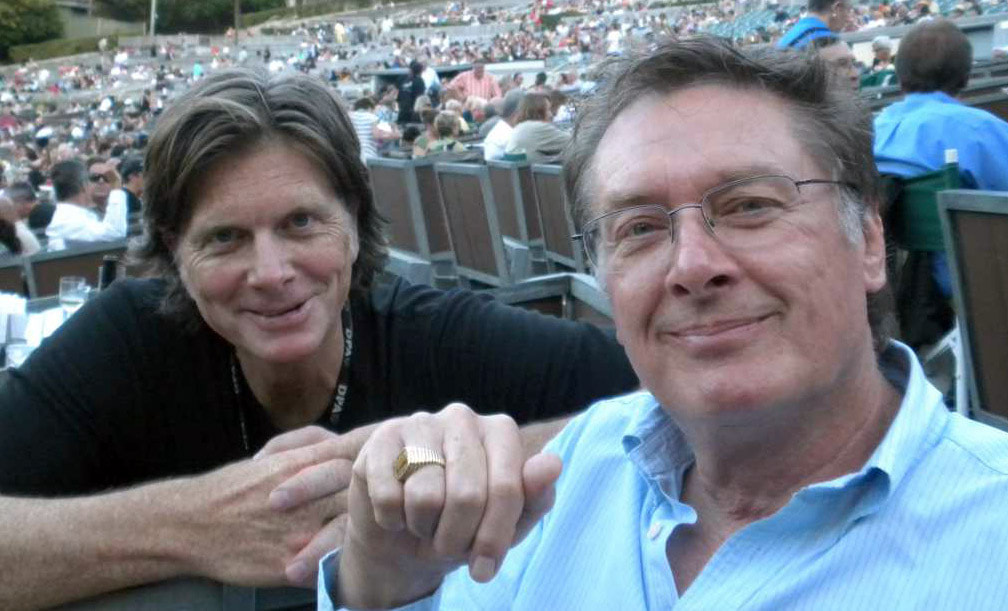
Fred Vogler and Bruce Jackson at the Hollywood Bowl, 2010
On Being a live soundman
"My name is Fred Vogler. I'm the principal sound designer at the Hollywood Bowl, California. I became acquainted with Bruce back in 1993. There was, I guess, a coming-out concert with Barbra Streisand and she was going to feature an orchestra and some of her big show tunes. She hadn't played live for 25 years and a combination of people were being assembled for this and I got pulled in to help with the orchestra because I have a background in orchestral sound, and mainly as a recording engineer at that time.
So I came into the world of Jackson and the whole Clair scene kind of not knowing what I was going to see, and at the time it was pretty overwhelming. There was a lot of people involved. You know, it was a big show and a well-know artist, Barbra Streisand, so I kind of got catapulted into the A team right away. It was evident that the people involved were all highly skilled and had done this before.
And it's funny because my original relationship with Bruce wasn't particularly good. I don't think he cared for a person coming in with a recording background and not in live sound. There was a question in his mind as well as some of the crew … as to whether I was going to be able to handle it, even though it wasn't going to be quite like the road tour that maybe some of these cats had had.
The shows went well; we ended up going on tour. These initial shows were just kind of Christmas or New Year's shows to see what was going to be made of it, and we took off on this tour and I came into Bruce a fair amount more because on those original shows there were just too many people, too much action. And again, right out of the gate I would say it was a little sketchy, you know, watching or trying to prove yourself or trying to make sense. Bruce had a notion that still amuses me today that I didn't need to be in the house. My job was to create an orchestra sound and then send that to the monitor folks, whether it was her personal monitor on stage, the mixer or the monitor for the band or orchestra, or to the front of house, so I wasn't out in the house and he would chide me a little bit about not being distracted and focus just on getting that good orchestral sound and I would say, 'I need to see what's coming', and he would say, 'No, no', and some of the times out on tour going from venue to venue I'd end up in the hallway that had star dressing rooms, and some of the times I'd end up two doors from Barbra's dressing room and sometimes I'd be literally in the shitter. In one of our setups there wasn't a dressing room for me and we took over a bathroom and that's where I worked and that was a big chuckle for the crew as I had to gaffer tape all the doors closed because I didn’t want all the guys coming in there and leaving anything that I would have to endure.
But what's funny about this is that the relationship with Bruce really started to grow and there was a method to his madness and I think we came out of this tour … OK. I mean I really looked up to him. I admired how hard he worked and how determined and particular he was about all the details of the system.
When we finished that tour, we came back, and did a couple of one-offs and he would invite me on certain adventures: we would go flying or I would see him at a Trade Show or something. We started to become sort of closer and closer. I really enjoyed being able to look at Bruce and talk to Bruce and bounce ideas off of Bruce, so it was natural when we did, I think it was two or three … we did several shows together and then in 2003 I was asked to join the team for the Hollywood Bowl. The Hollywood Bowl being this prestigious live sound venue, probably the most prestigious live sound venue in the country … but it's arguable. There are other high profile venues but the Hollywood Bowl is certainly one of them and they asked me to sign on as a sound designer and principal mixer. Literally the first colleague I called was Bruce. I was so excited and I wanted to share that with Bruce but I also wanted his view on, 'What shall we do … what is the plan here?' He was an amazing resource for not only the manufacturers but also the technicians.
And Bruce jumped right in. We put in the first Lake processors. Most of the research to develop them had been funded by Clair so these processors weren't available until just about the time I took over the bowl and so we were able to get a jump on those processors for the Hollywood Bowl system the very first summer I was there and those processors were ahead of their time just like a lot of the stuff that Bruce was involved with in the design electronics so in the first year when I came in we had the same system that had been in place for quite a few years prior to my coming but we took all the front end out and all the electronics and got them out of the way and put those Lakes in: huge and noticeable improvement right out of the gate and it was exactly what I needed to do. I needed to come in, clean house a little bit but also step things up and Bruce was a tremendous ally for the cause.
In the following year there was a major reconstruction of the Hollywood Bowl; the sound system and everything was going to be evaluated and again Bruce was my go-to person and ally. We spent a lot of time talking and figuring and scratching our heads trying to figure out what was the best process and one of the things we thought necessary was an evaluation of competitive sound systems.
And historically I think it's the case with comparative evaluations that maybe someone has an interest in one of them so that one kind of gets a favoured position or favoured, you know, look. And I didn't want that and Bruce didn't want that either; both of us were pretty true to finding what was the best sound system for this purpose … the repertoire can be very orchestral, or it's going to have a lot of acoustic material. So we picked a venue Chula Vista that was similar in size, it was outdoor. We picked the manufacturers of the speakers that we thought were going to be the most competitive and we proposed this whole idea…went to the Los Angeles Philharmonic who is the managing entity for the Hollywood Bowl and said, 'Hey, we need to do this whole evaluation', and they ponied up some money and we found a venue and we found someone to help someone contract all the vendors and bring them together and again, Bruce, watching him in this arena: A, he's well respected and, knowing everybody, when Bruce was there I knew it was going to be a fair shake. I knew that everybody would have to be at their best. No hanky-panky.
And sure enough, man, we did two different evaluations and both times it was classic because I was sort of senior in the cause because I was hired by the Philharmonic, Bruce was a consultant in helping put this together and he was tremendous…he'd walk right by me and if he thought something was going to go a little silly or there was something I needed to investigate a little but he'd just kind of whisper at me as we passed, 'Hey we might check out the such and such and make sure that's straight up'. And I’d go over there and say, ''Hey what are you guys doing here … what's this box?'.
So it was a nice thing to have someone like Bruce bring this together and kind of validate what we were up to, so my relationship grew over the years. I started working at the Bowl which does almost a hundred shows a season and as the sound designer I had plenty of input from other colleagues and we went through various other configurations of sound. We picked the sound system that we liked and then we changed the parameters of it a little bit and it was fun having Bruce come up and listen in and check out what we were up to. It was kind of an opportunity for me to show off a little bit, to pay back a little bit.
You know he and I had had our times together where it was his rig, and this was my rig and there was never any competitiveness or silliness. I looked up to him and this was the right deal and he was so supportive and I learned a lot from him. I look at him as someone who I would classify as a mentor. I learnt a lot, at least in relation to live sound and the process of producing good sound and also the process to ensure that you're not veering off because of emotional reasons; that you're being very objective in obtaining a quantifiable decision: that you're basing all of your decisions not on something that is personal but is on something that more people shares, so I think that when we evaluated sound systems and we looked at sound systems we looked at it not from what would suit us but what system would best suit the cause.
The other fun thing about Bruce was how inventive in the sense that there weren't any particular rules that you had to abide by all the time, there was no sense that, 'hey, it's all been figured out already, let's do it this way', it was maybe we can find a better way to do it.
And you know, interestingly, you learn a lot about people not just when they're living but when they're passed and it's amazing to me the resources that he had. I thought I knew a fair amount what he was up to but I think there was a whole bunch of stuff I didn't know and the depth of the people he touched. It's been kind of fun to connect with those people and realise how involved they were with Bruce too. So, it's an interesting journey.
When I was hired by the Philharmonic they already was a system design in place. In these type of projects it's not uncommon that you design the components for the technology that exists three or four years before construction. I was hired the summer before construction began so they already had a design in mind that used a lot of existing components and then put them into the shell or the facades so that they were hidden behind the facades themselves and then part of the design approach said that when there was a guest tour or some sort of a guest artist maybe they would hang their system in front of the existing system, and in front of the shell. And I had discussions with Bruce about this … this is nuts.
I mean in front is the optimum position, you want the speakers to be in front and you're a little further out into the house and you're not getting feedback issues on stage. It seemed like we would be allowing the guests to have the best position and we would have to live with being in a secondary position.
This wasn't good and again I was glad to have Bruce on my side and my team. We went through a lot of paperwork to promote this idea. The speakers had to come in front and whatever design had been in play before I had come along, was wrong.
It was actually a County of Los Angeles battle, they didn't want to make changes to the design. In their mind the system that had been suggested in the first place was correct. So we went out and had to do some modelling and rendering to show what everyone was asking: how's it going to look? How's the aesthetic going to be with the system in front?
And it's not only been accepted but it's been highly accepted and rewarding, as since we did the remodel with the hanging speakers it's been the top venue, at least by Pollstar standards, for the past eleven or twelve years in a row. And it had never won one of those before so I think that was validation of what we set out to do. It all worked out.
I was saying that being a Soundman was probably one of the most inglorious positions to have because someone is always criticizing your work, or not knowing you even existed…'Oh man the party sounded great tonight' they often don't attribute that to the sound person, they just think the orchestra sounded great or it's a great venue, or people say 'Man, you got such a great sound system'. Well, a great sound system in the hands of not a good mixer, or even and adequate mixer can sound terrible.
I sometimes liken it to a Stradivarius…a ten million dollar violin that is the most glorious biggest fattest sounding violin with the right technician will sound terrible in my hands…I'm not a violinist and the same with all this technology, they're just tools: the speakers and amps and then the designing and organising and figuring out the ratios and balance between these different entities is a really important job. You hear people's comments and criticisms regularly and at the level Bruce was mixing I'm sure he had to take an earful and had to constantly synthesise those comments and decide, 'Well, does this matter?'.
Most of the time, you know, it doesn’t matter. I think the people who are writing your cheques and paying your bills; they're the ones you have to pay attention to the most and then the artist of course is often involved.
You know when you are out in the house, you are front line (reference to the soundman being placed right in the audience), I mean maybe there's someone looking after you, maybe a guard, but by-and-large you are on your own. If the crowd goes crazy, or something is not working out, they're going to get on you.
At the Bowl I have a kind of concrete structure, where we can lock the door if something is not going well, but if you are out in the middle of an arena or something, maybe you're elevated but probably not: they want to have as many seats as possible so they put chairs as close as possible to you so half the time you're just surrounded by the masses and again, if something goes bad, they're not going to blame it on the technology, they're not going to blame it on the artist; they're going to blame it on you, the Soundman. It's a job where you have to be pretty thick-skinned and you have to be pretty much on your game.
You want to be stone sober, and really focussed and make sure you know all the whole signal path. You want to have contingency plans because when things do go wrong...it's not that things go wrong; it's possible at any moment that things could go down. You'd better have a contingency plan: you’d better not be standing there waiting for something to miraculously appear, you have to solve it and I'm sure Bruce had plenty of those moments. I didn't witness any but I think he had a plan thought out and did a lot of checking on the systems and was ready to go in several directions. Also he had a lot of good people around him…which is the other part of it: you want to make sure you have a good team.
You know it's a fun ride because you don't stop and take a break and then pick something up, you're part of the show. When the lights go down and the music starts to play, you're as much a performer as anybody on stage.
You're performing a mix that's integral to the experience of everybody in the house.
And it's always a pleasure to have somebody who cares about the sound or making a good sound. It's hard to go to see an artist who doesn't sound good, especially if you're in the business…you just think, 'Oh this is terrible' I mean, 'I love this artist but it just doesn't sound good'.
And there isn’t a licence or program or certificate that validates someone's ability to mix. Sometimes they're related to the artist; sometimes they're friends of the artist but it's great when somebody has a career or dedicated a lot of thought to the process and has the experience to back it up.
So that's the Soundman title, and it's a funny position.
I don't like the title particularly because it doesn't elevate or separate. You know sometimes I hear, 'Hey Soundman!', or 'Yo, Audio!'. We hear a lot of this kind of stuff but I think it requires someone with a lot of artistic skill as well as technical skill.
You know if you are a recording engineer you are recording something: you're capturing an event. And maybe there's a certain urgency to it because you are paying a lot of money for the time and everyone is together and you're trying to bring the musical moment together with these forces but what really separates those who can and those who cannot is the live stage, and you know all that trickery you can get away with in the studio … you can't get away with on the live stage so all the studio pitch shifting and all the kind of ... 'Let's redo this balance', and 'lets really focus on the kick drummer', and 'let's really focus on this sound' and 'Oh! such and such a device just stopped working. Let's take a break here, or take five', or 'let's go get something to eat, and then we'll come back to it'.
Not in a live show. In a live show you're off and you're going full speed ahead. And so, you go with reliable equipment…and maybe there's a better, higher performing microphone out there but in a live setting you have to go with stuff you can rely on. If the artist kicks over a stand you know that the microphone
is going to keep going and you're not going to suddenly have no sound.
So I think that the live person is somebody who deals with survival techniques in mixing whereas the person sitting in the studio can sit back and really finesse and organise but often it's a luxury position and not necessarily for the better.
With live the artist can really get excited and put on a show. When they're in the best form and you've got the audience responding so the performance can really elevate with the audience something that can never … or it's very difficult to recreate in a studio.
I think the opportunity for a live mixer to be part of that experience and that excitement is much greater than in a studio.
And I think that's part of the high of being a live sound guy. I think you want that.
When I talk to people they say, 'Hey, what is a sound guy really contributing?'
They say, 'You're just making that great artist sound better, you're not doing what the artist is doing'. And I say, 'What is Ansel Adams doing? Adams comes out with his camera and takes pictures of mountains … but he didn't make the mountains and he didn’t make the sky but he can capture that and make it look artistic and have a quality that people identify as art. It's the same with the Sound Guy, he's taking these elements … maybe he's not creating these elements but he's bringing them out and pushing them out and the response from the audience is something bigger than life and suddenly everyone goes: 'Wow! What an experience!'
Of course it's the sound that the artist is creating but it's the sound that the sound mixer is responsible for and again, you can take same equipment that Adams used and give it to me and I won't get the same picture.
In the right hands, and with the right setup and the right ears … the right setup is very important. Bruce was always focussed on the setup, and where everyone's position was, and whether we had carpet down or whether we had absorptive material on the walls. He fought for that more than anybody I knew. He did not suffer fools, he did not like the fact that something wasn't completely in alignment, you know, whether the array was hanging a little too high or a little low and that's something that reminds of one of my earlier concerts on that Streisand tour. I was watching the guys who worked with Bruce. Sometimes we would be there before Bruce and they would be putting things in the air and organising the stuff and I remember one occasion where they had to take a bunch of stuff down and I was saying to the crew chief at the time, 'Jim, what's the deal?' and he goes, 'Well, it would have worked just fine but I know that Bruce wouldn't like the way this cable was hanging and it's better for us to take it all down and re-doing it now because I don't want him coming in here and making us do it. So we just decided to do it'.
And that's the kind of attention to detail that Bruce really focused on and that was his reputation. Everybody knew that , 'Hey, we're not short-cutting this; we're going to go the distance and do it the right way'.
If you don't think about it beforehand and have the whole thing figured out way in advance … it's part of the plan, part of the contingency. If something doesn't go right you know where all the components are and why they're there."
So I came into the world of Jackson and the whole Clair scene kind of not knowing what I was going to see, and at the time it was pretty overwhelming. There was a lot of people involved. You know, it was a big show and a well-know artist, Barbra Streisand, so I kind of got catapulted into the A team right away. It was evident that the people involved were all highly skilled and had done this before.
And it's funny because my original relationship with Bruce wasn't particularly good. I don't think he cared for a person coming in with a recording background and not in live sound. There was a question in his mind as well as some of the crew … as to whether I was going to be able to handle it, even though it wasn't going to be quite like the road tour that maybe some of these cats had had.
The shows went well; we ended up going on tour. These initial shows were just kind of Christmas or New Year's shows to see what was going to be made of it, and we took off on this tour and I came into Bruce a fair amount more because on those original shows there were just too many people, too much action. And again, right out of the gate I would say it was a little sketchy, you know, watching or trying to prove yourself or trying to make sense. Bruce had a notion that still amuses me today that I didn't need to be in the house. My job was to create an orchestra sound and then send that to the monitor folks, whether it was her personal monitor on stage, the mixer or the monitor for the band or orchestra, or to the front of house, so I wasn't out in the house and he would chide me a little bit about not being distracted and focus just on getting that good orchestral sound and I would say, 'I need to see what's coming', and he would say, 'No, no', and some of the times out on tour going from venue to venue I'd end up in the hallway that had star dressing rooms, and some of the times I'd end up two doors from Barbra's dressing room and sometimes I'd be literally in the shitter. In one of our setups there wasn't a dressing room for me and we took over a bathroom and that's where I worked and that was a big chuckle for the crew as I had to gaffer tape all the doors closed because I didn’t want all the guys coming in there and leaving anything that I would have to endure.
But what's funny about this is that the relationship with Bruce really started to grow and there was a method to his madness and I think we came out of this tour … OK. I mean I really looked up to him. I admired how hard he worked and how determined and particular he was about all the details of the system.
When we finished that tour, we came back, and did a couple of one-offs and he would invite me on certain adventures: we would go flying or I would see him at a Trade Show or something. We started to become sort of closer and closer. I really enjoyed being able to look at Bruce and talk to Bruce and bounce ideas off of Bruce, so it was natural when we did, I think it was two or three … we did several shows together and then in 2003 I was asked to join the team for the Hollywood Bowl. The Hollywood Bowl being this prestigious live sound venue, probably the most prestigious live sound venue in the country … but it's arguable. There are other high profile venues but the Hollywood Bowl is certainly one of them and they asked me to sign on as a sound designer and principal mixer. Literally the first colleague I called was Bruce. I was so excited and I wanted to share that with Bruce but I also wanted his view on, 'What shall we do … what is the plan here?' He was an amazing resource for not only the manufacturers but also the technicians.
And Bruce jumped right in. We put in the first Lake processors. Most of the research to develop them had been funded by Clair so these processors weren't available until just about the time I took over the bowl and so we were able to get a jump on those processors for the Hollywood Bowl system the very first summer I was there and those processors were ahead of their time just like a lot of the stuff that Bruce was involved with in the design electronics so in the first year when I came in we had the same system that had been in place for quite a few years prior to my coming but we took all the front end out and all the electronics and got them out of the way and put those Lakes in: huge and noticeable improvement right out of the gate and it was exactly what I needed to do. I needed to come in, clean house a little bit but also step things up and Bruce was a tremendous ally for the cause.
In the following year there was a major reconstruction of the Hollywood Bowl; the sound system and everything was going to be evaluated and again Bruce was my go-to person and ally. We spent a lot of time talking and figuring and scratching our heads trying to figure out what was the best process and one of the things we thought necessary was an evaluation of competitive sound systems.
And historically I think it's the case with comparative evaluations that maybe someone has an interest in one of them so that one kind of gets a favoured position or favoured, you know, look. And I didn't want that and Bruce didn't want that either; both of us were pretty true to finding what was the best sound system for this purpose … the repertoire can be very orchestral, or it's going to have a lot of acoustic material. So we picked a venue Chula Vista that was similar in size, it was outdoor. We picked the manufacturers of the speakers that we thought were going to be the most competitive and we proposed this whole idea…went to the Los Angeles Philharmonic who is the managing entity for the Hollywood Bowl and said, 'Hey, we need to do this whole evaluation', and they ponied up some money and we found a venue and we found someone to help someone contract all the vendors and bring them together and again, Bruce, watching him in this arena: A, he's well respected and, knowing everybody, when Bruce was there I knew it was going to be a fair shake. I knew that everybody would have to be at their best. No hanky-panky.
And sure enough, man, we did two different evaluations and both times it was classic because I was sort of senior in the cause because I was hired by the Philharmonic, Bruce was a consultant in helping put this together and he was tremendous…he'd walk right by me and if he thought something was going to go a little silly or there was something I needed to investigate a little but he'd just kind of whisper at me as we passed, 'Hey we might check out the such and such and make sure that's straight up'. And I’d go over there and say, ''Hey what are you guys doing here … what's this box?'.
So it was a nice thing to have someone like Bruce bring this together and kind of validate what we were up to, so my relationship grew over the years. I started working at the Bowl which does almost a hundred shows a season and as the sound designer I had plenty of input from other colleagues and we went through various other configurations of sound. We picked the sound system that we liked and then we changed the parameters of it a little bit and it was fun having Bruce come up and listen in and check out what we were up to. It was kind of an opportunity for me to show off a little bit, to pay back a little bit.
You know he and I had had our times together where it was his rig, and this was my rig and there was never any competitiveness or silliness. I looked up to him and this was the right deal and he was so supportive and I learned a lot from him. I look at him as someone who I would classify as a mentor. I learnt a lot, at least in relation to live sound and the process of producing good sound and also the process to ensure that you're not veering off because of emotional reasons; that you're being very objective in obtaining a quantifiable decision: that you're basing all of your decisions not on something that is personal but is on something that more people shares, so I think that when we evaluated sound systems and we looked at sound systems we looked at it not from what would suit us but what system would best suit the cause.
The other fun thing about Bruce was how inventive in the sense that there weren't any particular rules that you had to abide by all the time, there was no sense that, 'hey, it's all been figured out already, let's do it this way', it was maybe we can find a better way to do it.
And you know, interestingly, you learn a lot about people not just when they're living but when they're passed and it's amazing to me the resources that he had. I thought I knew a fair amount what he was up to but I think there was a whole bunch of stuff I didn't know and the depth of the people he touched. It's been kind of fun to connect with those people and realise how involved they were with Bruce too. So, it's an interesting journey.
When I was hired by the Philharmonic they already was a system design in place. In these type of projects it's not uncommon that you design the components for the technology that exists three or four years before construction. I was hired the summer before construction began so they already had a design in mind that used a lot of existing components and then put them into the shell or the facades so that they were hidden behind the facades themselves and then part of the design approach said that when there was a guest tour or some sort of a guest artist maybe they would hang their system in front of the existing system, and in front of the shell. And I had discussions with Bruce about this … this is nuts.
I mean in front is the optimum position, you want the speakers to be in front and you're a little further out into the house and you're not getting feedback issues on stage. It seemed like we would be allowing the guests to have the best position and we would have to live with being in a secondary position.
This wasn't good and again I was glad to have Bruce on my side and my team. We went through a lot of paperwork to promote this idea. The speakers had to come in front and whatever design had been in play before I had come along, was wrong.
It was actually a County of Los Angeles battle, they didn't want to make changes to the design. In their mind the system that had been suggested in the first place was correct. So we went out and had to do some modelling and rendering to show what everyone was asking: how's it going to look? How's the aesthetic going to be with the system in front?
And it's not only been accepted but it's been highly accepted and rewarding, as since we did the remodel with the hanging speakers it's been the top venue, at least by Pollstar standards, for the past eleven or twelve years in a row. And it had never won one of those before so I think that was validation of what we set out to do. It all worked out.
I was saying that being a Soundman was probably one of the most inglorious positions to have because someone is always criticizing your work, or not knowing you even existed…'Oh man the party sounded great tonight' they often don't attribute that to the sound person, they just think the orchestra sounded great or it's a great venue, or people say 'Man, you got such a great sound system'. Well, a great sound system in the hands of not a good mixer, or even and adequate mixer can sound terrible.
I sometimes liken it to a Stradivarius…a ten million dollar violin that is the most glorious biggest fattest sounding violin with the right technician will sound terrible in my hands…I'm not a violinist and the same with all this technology, they're just tools: the speakers and amps and then the designing and organising and figuring out the ratios and balance between these different entities is a really important job. You hear people's comments and criticisms regularly and at the level Bruce was mixing I'm sure he had to take an earful and had to constantly synthesise those comments and decide, 'Well, does this matter?'.
Most of the time, you know, it doesn’t matter. I think the people who are writing your cheques and paying your bills; they're the ones you have to pay attention to the most and then the artist of course is often involved.
You know when you are out in the house, you are front line (reference to the soundman being placed right in the audience), I mean maybe there's someone looking after you, maybe a guard, but by-and-large you are on your own. If the crowd goes crazy, or something is not working out, they're going to get on you.
At the Bowl I have a kind of concrete structure, where we can lock the door if something is not going well, but if you are out in the middle of an arena or something, maybe you're elevated but probably not: they want to have as many seats as possible so they put chairs as close as possible to you so half the time you're just surrounded by the masses and again, if something goes bad, they're not going to blame it on the technology, they're not going to blame it on the artist; they're going to blame it on you, the Soundman. It's a job where you have to be pretty thick-skinned and you have to be pretty much on your game.
You want to be stone sober, and really focussed and make sure you know all the whole signal path. You want to have contingency plans because when things do go wrong...it's not that things go wrong; it's possible at any moment that things could go down. You'd better have a contingency plan: you’d better not be standing there waiting for something to miraculously appear, you have to solve it and I'm sure Bruce had plenty of those moments. I didn't witness any but I think he had a plan thought out and did a lot of checking on the systems and was ready to go in several directions. Also he had a lot of good people around him…which is the other part of it: you want to make sure you have a good team.
You know it's a fun ride because you don't stop and take a break and then pick something up, you're part of the show. When the lights go down and the music starts to play, you're as much a performer as anybody on stage.
You're performing a mix that's integral to the experience of everybody in the house.
And it's always a pleasure to have somebody who cares about the sound or making a good sound. It's hard to go to see an artist who doesn't sound good, especially if you're in the business…you just think, 'Oh this is terrible' I mean, 'I love this artist but it just doesn't sound good'.
And there isn’t a licence or program or certificate that validates someone's ability to mix. Sometimes they're related to the artist; sometimes they're friends of the artist but it's great when somebody has a career or dedicated a lot of thought to the process and has the experience to back it up.
So that's the Soundman title, and it's a funny position.
I don't like the title particularly because it doesn't elevate or separate. You know sometimes I hear, 'Hey Soundman!', or 'Yo, Audio!'. We hear a lot of this kind of stuff but I think it requires someone with a lot of artistic skill as well as technical skill.
You know if you are a recording engineer you are recording something: you're capturing an event. And maybe there's a certain urgency to it because you are paying a lot of money for the time and everyone is together and you're trying to bring the musical moment together with these forces but what really separates those who can and those who cannot is the live stage, and you know all that trickery you can get away with in the studio … you can't get away with on the live stage so all the studio pitch shifting and all the kind of ... 'Let's redo this balance', and 'lets really focus on the kick drummer', and 'let's really focus on this sound' and 'Oh! such and such a device just stopped working. Let's take a break here, or take five', or 'let's go get something to eat, and then we'll come back to it'.
Not in a live show. In a live show you're off and you're going full speed ahead. And so, you go with reliable equipment…and maybe there's a better, higher performing microphone out there but in a live setting you have to go with stuff you can rely on. If the artist kicks over a stand you know that the microphone
is going to keep going and you're not going to suddenly have no sound.
So I think that the live person is somebody who deals with survival techniques in mixing whereas the person sitting in the studio can sit back and really finesse and organise but often it's a luxury position and not necessarily for the better.
With live the artist can really get excited and put on a show. When they're in the best form and you've got the audience responding so the performance can really elevate with the audience something that can never … or it's very difficult to recreate in a studio.
I think the opportunity for a live mixer to be part of that experience and that excitement is much greater than in a studio.
And I think that's part of the high of being a live sound guy. I think you want that.
When I talk to people they say, 'Hey, what is a sound guy really contributing?'
They say, 'You're just making that great artist sound better, you're not doing what the artist is doing'. And I say, 'What is Ansel Adams doing? Adams comes out with his camera and takes pictures of mountains … but he didn't make the mountains and he didn’t make the sky but he can capture that and make it look artistic and have a quality that people identify as art. It's the same with the Sound Guy, he's taking these elements … maybe he's not creating these elements but he's bringing them out and pushing them out and the response from the audience is something bigger than life and suddenly everyone goes: 'Wow! What an experience!'
Of course it's the sound that the artist is creating but it's the sound that the sound mixer is responsible for and again, you can take same equipment that Adams used and give it to me and I won't get the same picture.
In the right hands, and with the right setup and the right ears … the right setup is very important. Bruce was always focussed on the setup, and where everyone's position was, and whether we had carpet down or whether we had absorptive material on the walls. He fought for that more than anybody I knew. He did not suffer fools, he did not like the fact that something wasn't completely in alignment, you know, whether the array was hanging a little too high or a little low and that's something that reminds of one of my earlier concerts on that Streisand tour. I was watching the guys who worked with Bruce. Sometimes we would be there before Bruce and they would be putting things in the air and organising the stuff and I remember one occasion where they had to take a bunch of stuff down and I was saying to the crew chief at the time, 'Jim, what's the deal?' and he goes, 'Well, it would have worked just fine but I know that Bruce wouldn't like the way this cable was hanging and it's better for us to take it all down and re-doing it now because I don't want him coming in here and making us do it. So we just decided to do it'.
And that's the kind of attention to detail that Bruce really focused on and that was his reputation. Everybody knew that , 'Hey, we're not short-cutting this; we're going to go the distance and do it the right way'.
If you don't think about it beforehand and have the whole thing figured out way in advance … it's part of the plan, part of the contingency. If something doesn't go right you know where all the components are and why they're there."
Who invented stage monitors?
|
Elvis had complained that he couldn't hear himself on stage. On his first tour with him, in November 1971 (the first also for Clair Brothers), Bruce introduced the slant stage monitors that Clair Brothers had recently developed. At first, Bruce mixed them sitting alongside Bill Porter at the main desk. Stan Horine would be stageside talking to Bruce throughout the show. Bruce would hear through his headphones instructions from Stan, 'Can you increase the volume a little? ... a little more ... OK that's it.' That was never going to work.
On his second tour with Elvis, in 1972, it was Bruce's idea to move the stage monitoring position from the main desk down to a position immediately adjacent to the stage, putting him in close contact with Elvis during the show. Elvis could talk to Bruce on any issue with the sound, which was initially both a good and bad thing. In our book Bruce recalls being embarrassed when asked to come up on stage to hear what Elvis thought was a problem. Elvis, in a playful mood sometimes, would mess with Bruce by placing his microphone close enough to a monitor to cause feedback, and then warn Bruce to, 'Watch that feedback, Jackson.'
Bruce developed the function and efficiency of the stage monitor but Roy Clair can take credit for inventing it. Roy's account is in our book: "In those days it was easier to make things ourselves rather than spend time talking with manufacturers trying to persuade someone to take what |
we were doing seriously. After the double woofer box, the second thing we made was a slant stage monitor. Back then there weren't stage monitors, just normal boxes tilted crudely up towards the entertainer. I was mixing the desk and looking at Blood, Sweat and Tears one night and noticed that their legs from the knee down were mostly obscured by these awkwardly tilted boxes. There were ugly so I started thinking how we could lower the profile to make them less intrusive. It occurred to me that if we built a speaker box that sat flat on the stage but held the speaker on a slant, we could reduce the height of the current system by half.
One of my biggest interests was woodworking so I had no problem making all our speaker boxes myself and making modifications along the way to be sure they were stiffer than other boxes. Then I did the doubling up with the speakers to see if that worked, and it did. I went home and built in the workshop what I had in mind for a slant monitor and got JBL components to fit into it. We then developed it for Blood, Sweat and Tears. At that time they were renting an old tilted box system from McCune in San Francisco. I asked the band manager, 'If we did a better stage monitoring system would you be interested?' The said, 'Yes Roy, of course.' So Blood, Sweat and Tears were the first to use our slant monitors. Bill Handley said they should have asked him because he had a slant monitor, but not really. All he had was a quarter speaker box that was designed to fit into a corner. If you lay it on its side it kind of slanted up towards the entertainer. So who's to say but I think we were the first to build a slant monitor for the industry." - Roy Clair. Clair Brothers was contracted in 1971 by Tom Hulett to go on tour with Elvis and do every show, where previously a variety of regional sound companies were used. Clair Brothers brought quality, consistency and endless innovation to Elvis's sound, such as Roy's super-tight double-woofer box and slant monitor. And so things continued to improve for Elvis over the next six years with Clair Brothers doing every show. The full story is in the book, a fascinating look into rock'n'roll history. |
